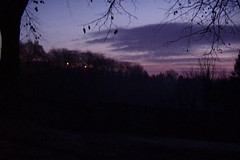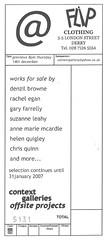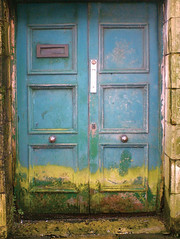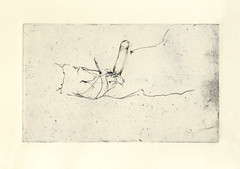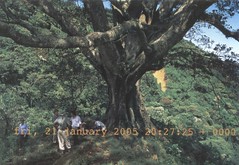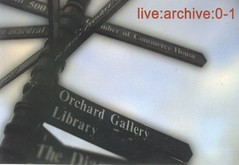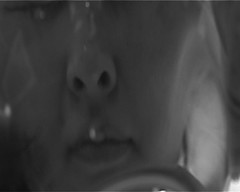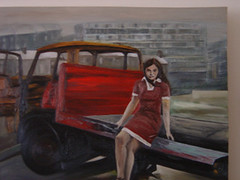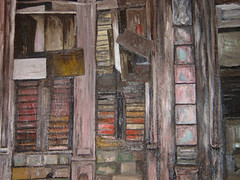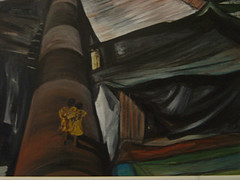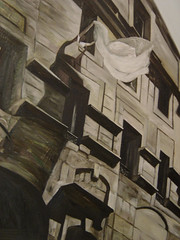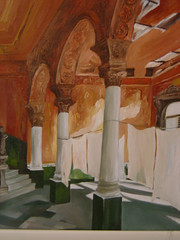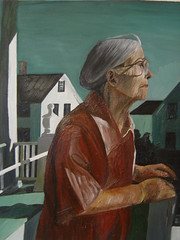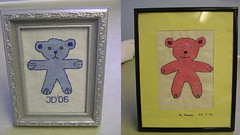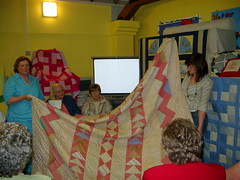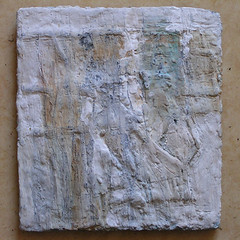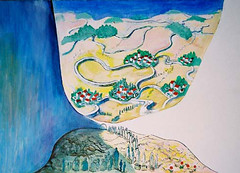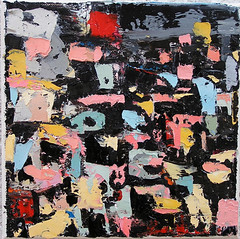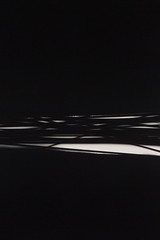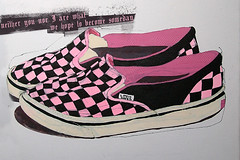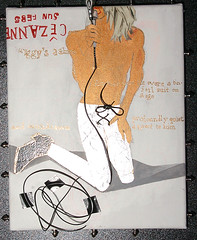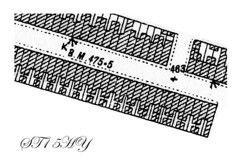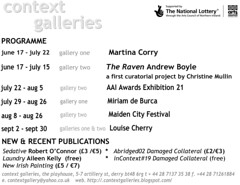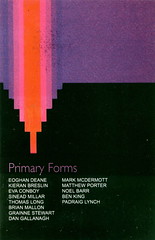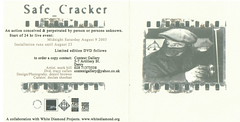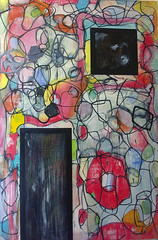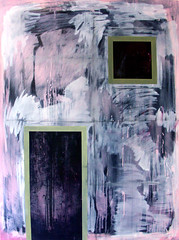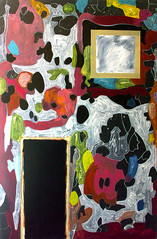Miriam de Burca, 'Stealing Weeds'
16th December 2006 – 20th January 2007
Miriam de Burca is currently completing a practice based PhD at University of Ulster. Recent projects include: The Golden Mile, Belfast 2003; Veneer/Folheado, Galeria Zedosbois, Lisbon, Portugal 2003; BE+FAST, Ljubljana, Slovenia 2004; The Belfast Way, Herzilya Museum of Contemporary Art, Tel Aviv, Israel 2005; Perspective, Ormeau Baths, Belfast 2005; Dogs Have No Religion, Artists From Northern Ireland at Czech Museum of Fine Arts, 2006.
Weeds have grown from soil recently fertilised by the ashes of an 11th Night bonfire. The wasteland’s annual cycle of construction and subsequent destruction has entered into its interval phase; the return of the small organisms. Benefiting from the minerals left by the fire, they begin to re-inhabit the area, slowly building up a temporary landscape.
A contradiction in terms, it would seem, ‘stealing weeds’. How can it be stealing if they are only weeds? And, if they are considered to be of no worth, why would one feel the need to go to such lengths? After all, they grow abundantly and thrive wherever the ground offers the minimum requirements for light, nutrition and drainage. They are considered a nuisance; they spring up where they are not wanted. Yet here they are being specially selected, uprooted, and taken away. Should anyone have objected to it?
Is it not a form of colonisation when one aggressively tears at the ground and takes elements of it away for scrutiny?
More important than the question whether digging up the plants is theft or not, is the fact that it feels like theft. The physical act of crossing through the implicit threshold and into the centre of the interface gives the sensation of making an imposition. There is a psychological heat still emanating from the ashen ground that causes one to hurry, to step and dig and leave quickly. (‘Careful or you’ll burn the soles of your feet.’)
Ultimately, there is no feeling of victory, no conquest made. Rather than gaining a sense of ownership over that proximate piece of land, the psychological boundary between ‘here and there’ remains as intact as before, the experience leaving only a slight feeling of guilt; that the weeds had been taken from someone else’s land; de facto stolen.
Miriam de Búrca
Miriam de Burca is currently completing a practice based PhD at University of Ulster. Recent projects include: The Golden Mile, Belfast 2003; Veneer/Folheado, Galeria Zedosbois, Lisbon, Portugal 2003; BE+FAST, Ljubljana, Slovenia 2004; The Belfast Way, Herzilya Museum of Contemporary Art, Tel Aviv, Israel 2005; Perspective, Ormeau Baths, Belfast 2005; Dogs Have No Religion, Artists From Northern Ireland at Czech Museum of Fine Arts, 2006.
Weeds have grown from soil recently fertilised by the ashes of an 11th Night bonfire. The wasteland’s annual cycle of construction and subsequent destruction has entered into its interval phase; the return of the small organisms. Benefiting from the minerals left by the fire, they begin to re-inhabit the area, slowly building up a temporary landscape.
A contradiction in terms, it would seem, ‘stealing weeds’. How can it be stealing if they are only weeds? And, if they are considered to be of no worth, why would one feel the need to go to such lengths? After all, they grow abundantly and thrive wherever the ground offers the minimum requirements for light, nutrition and drainage. They are considered a nuisance; they spring up where they are not wanted. Yet here they are being specially selected, uprooted, and taken away. Should anyone have objected to it?
Is it not a form of colonisation when one aggressively tears at the ground and takes elements of it away for scrutiny?
More important than the question whether digging up the plants is theft or not, is the fact that it feels like theft. The physical act of crossing through the implicit threshold and into the centre of the interface gives the sensation of making an imposition. There is a psychological heat still emanating from the ashen ground that causes one to hurry, to step and dig and leave quickly. (‘Careful or you’ll burn the soles of your feet.’)
Ultimately, there is no feeling of victory, no conquest made. Rather than gaining a sense of ownership over that proximate piece of land, the psychological boundary between ‘here and there’ remains as intact as before, the experience leaving only a slight feeling of guilt; that the weeds had been taken from someone else’s land; de facto stolen.
Miriam de Búrca
Points of Departure, Christine Mackey
Points of Departure
Christine Mackey
gallery one, nov 11 – dec 9
Christine Mackey gained a BA Sculpture in NCAD Dublin 1992, and MA Visual Performance, Dartington College, 2002. She was nominated as one of four finalists for the AIB Award 2004.
The work in this exhibition stems from Christine Mackey’s response to her travels in Central America and particularly her response to the terrain and the people she encountered there. She was artist in residence in Teor e/Tica, San José, the capital and largest city in Costa Rica, located in the center of the country, high on a mountain plateau.
The central premise of this work deals in terms of an anthropological (the study of humankind) practice but one it terms of collecting, through which a local knowledge of place is gained through an ongoing dialogical exchange both physically and virtually. Grant Kester, assistant professor of contemporary art history and theory at Arizona State University, has given a useful description of a dialogical relationship in artwork as follows: “a dialogical relationship that breaks down the conventional distinction between artist, art work and audience - a relationship that allows the viewer to "speak back" to the artist in certain ways, and in which this reply becomes in effect a part of the "work" itself” (Dialogical Aesthetics: A Critical Framework For Littoral Art, Grant Kester, Variant issue 9)
Christine Mackey’s method of working, which she terms ‘Process in Motion’ relates to the actual gaining of knowledge about a civilization or community through collation and discoveries. In essence the exhibition is an archival installation of her travels and experiences in Central America and research into its artists and their response to their environment. Thus she decided to build an archive of Central American artists that amounted to small art works, documentation of artists work on CD and DVD, catalogues and books related to Central American artists and current arts practice. She is appropriating methods used by archivists in this project. She doesn’t intend this project to be an exhaustive archive of Central American art and artists. Rather she is using archival methods to visually articulate her personal (and that of the artists she encountered) response to the local environment and populace. She is also entwining her own personal circumstance into the work, in this case the tragic death of her mother, Brigid, in a car accident whilst the artist was in Panama. She is placing subjective experience into mapping and the archiving resulting from that mapping.
The nature and use of archives are being changed, particularly through artists using methods and terminology traditionally used by archivists. Traditionally archives stood for a ‘dead-end’ comprehensiveness where as many documents as possible about a particular subject filled many boxes on dusty shelves. Artists by questioning the nature, role and use of data and their appropriation and creative updating of archival methods have created a debate about the definition of an archive.
Christine Mackey commissioned a number of artists, an art critic and an environmental sociologist to develop textual work or small sketches in relation to a short text that she gave them to respond to. She is interested in the tactics used by individuals and artists to navigate daily existence in environment where local and globalised strategies are imposed upon them by local and outside agencies. In this she is influenced by the French philosopher Michael de Certeau who explored the ‘tactics’ used by people to adapt to ‘strategies’ imposed upon them by for example government. She is also influenced by the anthropologist James Clifford’s recent work concerns the response of local politics to globalization. He is researching the effects of regional, national, and international power on different cultures by studying museums, festivals, tourism, and ethnic performance. Much of his work focuses the decolonization of the pacific region and its impact on the culture of the indigenous people such as native Californians pacific islanders.
This exhibition can be seen as an archival mapping of the artist’s journey in Central America. As the artist puts it: ‘the exhibition thus ‘constitutes an assembly of narratives and interchanges, moving from one place to another; an accumulation of voices between time zones and continents deliberated as a line across space and as a dedication to the memory of Brigid’.
The exhibition is accompanied by a limited edition 90 page full colour catalogue.
Christine Mackey
gallery one, nov 11 – dec 9
Christine Mackey gained a BA Sculpture in NCAD Dublin 1992, and MA Visual Performance, Dartington College, 2002. She was nominated as one of four finalists for the AIB Award 2004.
The work in this exhibition stems from Christine Mackey’s response to her travels in Central America and particularly her response to the terrain and the people she encountered there. She was artist in residence in Teor e/Tica, San José, the capital and largest city in Costa Rica, located in the center of the country, high on a mountain plateau.
The central premise of this work deals in terms of an anthropological (the study of humankind) practice but one it terms of collecting, through which a local knowledge of place is gained through an ongoing dialogical exchange both physically and virtually. Grant Kester, assistant professor of contemporary art history and theory at Arizona State University, has given a useful description of a dialogical relationship in artwork as follows: “a dialogical relationship that breaks down the conventional distinction between artist, art work and audience - a relationship that allows the viewer to "speak back" to the artist in certain ways, and in which this reply becomes in effect a part of the "work" itself” (Dialogical Aesthetics: A Critical Framework For Littoral Art, Grant Kester, Variant issue 9)
Christine Mackey’s method of working, which she terms ‘Process in Motion’ relates to the actual gaining of knowledge about a civilization or community through collation and discoveries. In essence the exhibition is an archival installation of her travels and experiences in Central America and research into its artists and their response to their environment. Thus she decided to build an archive of Central American artists that amounted to small art works, documentation of artists work on CD and DVD, catalogues and books related to Central American artists and current arts practice. She is appropriating methods used by archivists in this project. She doesn’t intend this project to be an exhaustive archive of Central American art and artists. Rather she is using archival methods to visually articulate her personal (and that of the artists she encountered) response to the local environment and populace. She is also entwining her own personal circumstance into the work, in this case the tragic death of her mother, Brigid, in a car accident whilst the artist was in Panama. She is placing subjective experience into mapping and the archiving resulting from that mapping.
The nature and use of archives are being changed, particularly through artists using methods and terminology traditionally used by archivists. Traditionally archives stood for a ‘dead-end’ comprehensiveness where as many documents as possible about a particular subject filled many boxes on dusty shelves. Artists by questioning the nature, role and use of data and their appropriation and creative updating of archival methods have created a debate about the definition of an archive.
Christine Mackey commissioned a number of artists, an art critic and an environmental sociologist to develop textual work or small sketches in relation to a short text that she gave them to respond to. She is interested in the tactics used by individuals and artists to navigate daily existence in environment where local and globalised strategies are imposed upon them by local and outside agencies. In this she is influenced by the French philosopher Michael de Certeau who explored the ‘tactics’ used by people to adapt to ‘strategies’ imposed upon them by for example government. She is also influenced by the anthropologist James Clifford’s recent work concerns the response of local politics to globalization. He is researching the effects of regional, national, and international power on different cultures by studying museums, festivals, tourism, and ethnic performance. Much of his work focuses the decolonization of the pacific region and its impact on the culture of the indigenous people such as native Californians pacific islanders.
This exhibition can be seen as an archival mapping of the artist’s journey in Central America. As the artist puts it: ‘the exhibition thus ‘constitutes an assembly of narratives and interchanges, moving from one place to another; an accumulation of voices between time zones and continents deliberated as a line across space and as a dedication to the memory of Brigid’.
The exhibition is accompanied by a limited edition 90 page full colour catalogue.
Live Archive 0 – 1
North West Visual Arts Archive
@ Context Galleries 2
11th November – 09th December 2006
The North West Visual Arts Archive presents Live Archive 0 – 1 the first of its Live Archive exhibition/project programme. Live Archive 0 – 1 is a linear history of Derry’s now defunct Orchard Gallery in installation form using gallery ephemera such as catalogues, invitation cards, gallery handouts and reviews.
The Orchard Gallery ran from 1978 to 2003 and established itself as an exciting and innovative institution at the forefront of contemporary art showing many of the leading names of Irish, European and world art. It put Derry on the world map as far as contemporary art was concerned. The installation is also an interactive research project which will offer the public the opportunity to contribute their memories, anecdotes and opinions of the gallery to the project thus creating a written narrative to accompany the exhibition. It is important that a regional arts archive protects and explores the local arts heritage of the area, as the nature of visual art is often very ephemeral and easily lost. But with the Live Archive projects this heritage will be updated and added to in an imaginative and thought-provoking manner. It is also very apparent that the meaning of the term ‘archive’ is no longer fixed. Many artists have appropriated archival terminology and strategies and used them in their own work thus there is now a fluidity of definition as to what archiving actually means. The North West Visual Arts Archive recognises this and will explore new methods of articulating the remit of the archive.
The North West Visual Arts Archive aims to accumulate, collate and make publicly available a coherently structured and easily accessible visual arts archive covering the local North West region, encompassing the counties of Derry, Fermanagh, Tyrone, Cavan, Donegal, Leitrim, Mayo, Roscommon and Sligo. The archive is continually added to and updated as new documents become available.
The archive is not intended to be merely a passive resource. Rather it is envisaged as a living entity with exhibitions, publications, lectures and workshops evolving from it. The Live Archive project is designed to visually articulate the remit of the archive and as a means of supporting local artistic practice and indeed the contemporary art scene in the North West. Archives have the capacity to cross artistic disciplines and boundaries and use multiple formats to initiate creative dialogue and projects with regard to past, present and future art production in the region.
At the end of Live Art: 0 – 1 The North West Visual Arts Archive will move to its permanent home in the Verbal Arts Centre, Derry though will continue to initiate off-site Live Archive projects, the first planned for spring/summer 2007 being a project looking at Derry art and artists working today.
Thanks to Colin Darke for permission to use his research notes on the early years of the gallery.
Live Archive 0 – 1:
Gregory McCartney: Project Coordinator
Cinza Parola: Research Assistant
Mara Cavalli: Research Assistant
Email: nwarchives@yahoo.co.uk
@ Context Galleries 2
11th November – 09th December 2006
The North West Visual Arts Archive presents Live Archive 0 – 1 the first of its Live Archive exhibition/project programme. Live Archive 0 – 1 is a linear history of Derry’s now defunct Orchard Gallery in installation form using gallery ephemera such as catalogues, invitation cards, gallery handouts and reviews.
The Orchard Gallery ran from 1978 to 2003 and established itself as an exciting and innovative institution at the forefront of contemporary art showing many of the leading names of Irish, European and world art. It put Derry on the world map as far as contemporary art was concerned. The installation is also an interactive research project which will offer the public the opportunity to contribute their memories, anecdotes and opinions of the gallery to the project thus creating a written narrative to accompany the exhibition. It is important that a regional arts archive protects and explores the local arts heritage of the area, as the nature of visual art is often very ephemeral and easily lost. But with the Live Archive projects this heritage will be updated and added to in an imaginative and thought-provoking manner. It is also very apparent that the meaning of the term ‘archive’ is no longer fixed. Many artists have appropriated archival terminology and strategies and used them in their own work thus there is now a fluidity of definition as to what archiving actually means. The North West Visual Arts Archive recognises this and will explore new methods of articulating the remit of the archive.
The North West Visual Arts Archive aims to accumulate, collate and make publicly available a coherently structured and easily accessible visual arts archive covering the local North West region, encompassing the counties of Derry, Fermanagh, Tyrone, Cavan, Donegal, Leitrim, Mayo, Roscommon and Sligo. The archive is continually added to and updated as new documents become available.
The archive is not intended to be merely a passive resource. Rather it is envisaged as a living entity with exhibitions, publications, lectures and workshops evolving from it. The Live Archive project is designed to visually articulate the remit of the archive and as a means of supporting local artistic practice and indeed the contemporary art scene in the North West. Archives have the capacity to cross artistic disciplines and boundaries and use multiple formats to initiate creative dialogue and projects with regard to past, present and future art production in the region.
At the end of Live Art: 0 – 1 The North West Visual Arts Archive will move to its permanent home in the Verbal Arts Centre, Derry though will continue to initiate off-site Live Archive projects, the first planned for spring/summer 2007 being a project looking at Derry art and artists working today.
Thanks to Colin Darke for permission to use his research notes on the early years of the gallery.
Live Archive 0 – 1:
Gregory McCartney: Project Coordinator
Cinza Parola: Research Assistant
Mara Cavalli: Research Assistant
Email: nwarchives@yahoo.co.uk
ruBbEr pLaNs, a film by alex cheung
In 2005, Context Galleries received a project award from the Promoting Interculturalism Programme of The Arts Council of Northern Ireland and Community Relations Council. Working with production company Plethora Productions, the project award was dedicated to developing and producing a new film and filmmaking skills base within the young Chinese community of the city of Derry. Rubber Plans, the film produced in the project and screened here, is the first short film by Alex Cheung, born and raised in the city, whose parents moved here from Hong Kong. The filmmaking process involved mentoring and training from Plethora Productions, Blast Furnace Recording Studios and Sound Engineer Kwame Daniels to a crew and cast from the young Chinese community of the city of Derry. Alongside the screenings here, the film Rubber Plans will be promoted to the international film festival circuit, further developing the potential of Northern Ireland’s first film from within the Chinese community.
Film screenings preview 8pm, Oct 7. Film screenings continue until Nov 4.
Film screenings preview 8pm, Oct 7. Film screenings continue until Nov 4.
Nuala Herron, Of Beauty in Ruin
Nuala Herron is a young painter from Derry, currently based in Edinburgh. The artist graduated in BA(Hons) Fine and Applied Art (Painting) at University of Ulster in 2003. Context Galleries is delighted to be bringing new work by this young artist to a first solo exhibition in her home town.
As a painter, I attempt to show beauty in what might often go unnoticed: everyday realities of the Domestic Life of a family, clothes hanging on a washing line, delapidated buildings.
In this collection of paintings I hope to show a glimpse of the frailty and transience of beauty in ruin. These ruins, delapidated and desolate scenes are a manifestation of my understanding of reality.
My paintings often evolve from photographs, some of which were taken while travelling around Europe. Rather than photographing the obvious I was more interested in delapidated buildings,walls and doors. These images were more significant to me and revealed more depth, value and beauty than their peeling surfaces suggested.
While I could appreciate the aesthetic of ruins I was also aware of a certain perversity by which we find pleasure in contemplating decay. With this in mind I have tried to create paintings 'Of Beauty in Ruin' which are honest and engaging.
Exhibition previews 8pm,Oct 7 Exhibition runs until Nov 4th
As a painter, I attempt to show beauty in what might often go unnoticed: everyday realities of the Domestic Life of a family, clothes hanging on a washing line, delapidated buildings.
In this collection of paintings I hope to show a glimpse of the frailty and transience of beauty in ruin. These ruins, delapidated and desolate scenes are a manifestation of my understanding of reality.
My paintings often evolve from photographs, some of which were taken while travelling around Europe. Rather than photographing the obvious I was more interested in delapidated buildings,walls and doors. These images were more significant to me and revealed more depth, value and beauty than their peeling surfaces suggested.
While I could appreciate the aesthetic of ruins I was also aware of a certain perversity by which we find pleasure in contemplating decay. With this in mind I have tried to create paintings 'Of Beauty in Ruin' which are honest and engaging.
Exhibition previews 8pm,Oct 7 Exhibition runs until Nov 4th
Nuala Herron, The Bogside
This painting was inspired by a photograph taken of my mother during the early part of The Troubles in 1971. It is set in Rosville Street, an area scarred by almost daily rioting, hijacking and vehicle burning. Although much of the scene is bleak and the truck has been burnt out, the prominence of the figure causes this to fade into the background. ( Painting: 3ft x 3ft, Oil on canvas)
Nuala Herron, Closed
From a photograph taken in Havana Cuba, I have attempted to capture the various textures seen on this boarded-up window: the peeling paint,the roughness of the stone,the burnt wood and flimsy cardboard.By building up several layers of paint and then scraping away some layers, I hoped to create a similar texture. (Painting: 3ftx3ft, Oil on canvas )
Nuala Herron, The Pipeline
Despite the poverty and devastation found in India, I have always been attracted to the colours and textures captured in many photographs taken. Having collected photographs for several years I had the urge to paint this particular scene, which shows a pipeline muscling snakelike through a suburb of Mumbai to supply rich areas with plenty of water. (3ftx3ft, Oil on canvas)
Nuala Herron, A Shadow Casted
In this painting, I have tried to capture a fleeting moment, something ordinary,everyday and potentially lost. The building itself is slightly decaying and the fact that it is painted prominently in shades of greys and brown enhances this. The white sheet which is being shook from the top window could signify many things, one being the continuity of life. ( painting: 3ftx3ft, Oil on canvas)
Nuala Herron, Besieged by Time
With an interest in washing lines and the feelings they connote for me, I wanted to bring this into at least one of my paintings. After discovering the photographer Robert Polidori, I came across a photograph called 'Palador La Guarida' from which I took inspiration for this painting. (3ftx3ft, Oil on canvas)
Nuala Herron, Searching
As a realist painter, I have always been drawn to painting older people and find it challenging to capture the the textures of their skin. I saw so much beauty and significance in this searching face which might be seen by many to be lost youth. I thought this was appropriate to include in my exhibition 'Of Beauty in Ruin.'
(3ftx3ft, oil on canvas)
(3ftx3ft, oil on canvas)
Nuala Herron ‘Beauty in Ruin’
In this collection of paintings the artist attempts to show a glimpse of the frailty and transience of beauty in ruin. Herron is exploring the picturesque, a time-honoured area of investigation for artists though of course putting it into a modern context. Picturesque meaning literally "in the manner of a picture; fit to be made into a picture" was a word used as early as 1703 (Oxford English Dictionary), and derived from an Italian term pittoresco, meaning, "in the manner of a painter," As meaning like beauty is transient the term ‘picturesque’ is now held in some distain and taken to mean simply pretty or charming.
In 18th Century philosophy and criticism it was however a valid stream of artistic exploration holding the middle ground between the beautiful (in the strictly traditional sense of classical i.e. Grecian aesthetic ideals) and the sublime (that appreciation of the vastness and terrible power of nature as articulated in the theories of philosophers Edmund Burke and Immanuel Kant). The picturesque borrowed from both extremes, conjoining elements of what was considered at the time ‘ideally’ beautiful (i.e. fitting the philosophical notions of beauty offered by notably the Greek philosopher and statesman Plato) with the non-rational (i.e. wild, instinctual, untamed and possibly dangerous) sublime. The notion of the picturesque was primarily articulated by the clergyman and writer William Gilpin in 1768 in a travel book designed for the English leisured classes, where he defined the picturesque as ‘that is what agreeable in a picture’. His perception of what was ‘agreeable’ however deviated from the norms of the time to include rugged landscapes and decaying buildings and even ‘decaying’ people. The artist includes portraits in her study of the potential beauty of decay and ruin. The equation of human aging with the decay of infrastructure has also a lengthy history which again leads ultimately back (in painting at least) to the theories of the Reverend Gilpin.
Unfortunately the picturesque became a fad and swarms of tourists pounced upon suitably craggy areas of England and Europe which eventually led to the devaluing of the term. Though even in the 19th Century the art critic and poet John Ruskin considered it a genuinely modern aesthetic category. Herron brings the picturesque into the contemporary context in this exhibition by including elements such as a study of an individual (her mother) in a post-riot landscape posing on a hijacked and subsequently burned vehicle and a landscape showing industrial intrusion, decay and pollution in India.
Herron’s paintings are often also studies in surface and colour which show the artist’s interest in portraying to a level which almost reaches the abstract, building facades, doors and shuttered windows. She takes the picturesque and often mixes it with painterly concerns in regard to technique and intertwines comments upon domesticity. These buildings are old and decaying but they are lived in. These areas have a massive pipeline running through it but people live and work there.
The artist often bases her painting on photographs, not always her own, thus appropriating other’s images for her own devices and reinterpreting them to give them new meaning. This can be seen in particular with her reinterpretation of a photograph by Robert Polidori of a building in Havana, Cuba in which the artist articulates her appreciation of decay and beauty and gives prominence to the obvious domestic associations of the building by highlighting the white sheets on the washing line.
(Text by Gregory McCartney)
This the artist’s first solo show in the Context though she did appear in the ‘Take Away’ group show in 2004.
The exhibition runs 7th October – 4th November 2006
In 18th Century philosophy and criticism it was however a valid stream of artistic exploration holding the middle ground between the beautiful (in the strictly traditional sense of classical i.e. Grecian aesthetic ideals) and the sublime (that appreciation of the vastness and terrible power of nature as articulated in the theories of philosophers Edmund Burke and Immanuel Kant). The picturesque borrowed from both extremes, conjoining elements of what was considered at the time ‘ideally’ beautiful (i.e. fitting the philosophical notions of beauty offered by notably the Greek philosopher and statesman Plato) with the non-rational (i.e. wild, instinctual, untamed and possibly dangerous) sublime. The notion of the picturesque was primarily articulated by the clergyman and writer William Gilpin in 1768 in a travel book designed for the English leisured classes, where he defined the picturesque as ‘that is what agreeable in a picture’. His perception of what was ‘agreeable’ however deviated from the norms of the time to include rugged landscapes and decaying buildings and even ‘decaying’ people. The artist includes portraits in her study of the potential beauty of decay and ruin. The equation of human aging with the decay of infrastructure has also a lengthy history which again leads ultimately back (in painting at least) to the theories of the Reverend Gilpin.
Unfortunately the picturesque became a fad and swarms of tourists pounced upon suitably craggy areas of England and Europe which eventually led to the devaluing of the term. Though even in the 19th Century the art critic and poet John Ruskin considered it a genuinely modern aesthetic category. Herron brings the picturesque into the contemporary context in this exhibition by including elements such as a study of an individual (her mother) in a post-riot landscape posing on a hijacked and subsequently burned vehicle and a landscape showing industrial intrusion, decay and pollution in India.
Herron’s paintings are often also studies in surface and colour which show the artist’s interest in portraying to a level which almost reaches the abstract, building facades, doors and shuttered windows. She takes the picturesque and often mixes it with painterly concerns in regard to technique and intertwines comments upon domesticity. These buildings are old and decaying but they are lived in. These areas have a massive pipeline running through it but people live and work there.
The artist often bases her painting on photographs, not always her own, thus appropriating other’s images for her own devices and reinterpreting them to give them new meaning. This can be seen in particular with her reinterpretation of a photograph by Robert Polidori of a building in Havana, Cuba in which the artist articulates her appreciation of decay and beauty and gives prominence to the obvious domestic associations of the building by highlighting the white sheets on the washing line.
(Text by Gregory McCartney)
This the artist’s first solo show in the Context though she did appear in the ‘Take Away’ group show in 2004.
The exhibition runs 7th October – 4th November 2006
Resident 4
Resident 4
An exhibition of works produced in the 4th year of the Context Galleries Education and Outreach Project: a collaborative project between the following artists and organisations:
Lilliput Theatre Group and Laura Saenz of The Dancing Tree have produced a video entitled ‘What is Love?’ exploring participants perceptions of love.
Greysteel Women’s Activity Group and Tina McLaughlin have made a series of beautiful patchwork quilts that articulate the tradition use of patch-working in the Derry area.
Ballylaw Women’s Group and Martha Lewtas have created a series of delicate embroidered pieces which display great skill and dexterity of all who participated.
Maybrook Adult Training Centre with Tracy Cullen and Danny Mc Laughlin have produced video and a collage of photographs exploring the group’s various activities in locations around Derry.
Finally, Context Galleries is pleased to have part of the Wheelworks ‘Respect’ project in the gallery. This project helps to increase tolerance and respect for each and every community in our society.
Galleries 1 & 2
Exhibition previews 6pm Saturday 2nd September
Exhibition runs until September 30th
Supported by Derry City Council, Adapt, Lottery Awards For All, and The Art Council of Northern Ireland
An exhibition of works produced in the 4th year of the Context Galleries Education and Outreach Project: a collaborative project between the following artists and organisations:
Lilliput Theatre Group and Laura Saenz of The Dancing Tree have produced a video entitled ‘What is Love?’ exploring participants perceptions of love.
Greysteel Women’s Activity Group and Tina McLaughlin have made a series of beautiful patchwork quilts that articulate the tradition use of patch-working in the Derry area.
Ballylaw Women’s Group and Martha Lewtas have created a series of delicate embroidered pieces which display great skill and dexterity of all who participated.
Maybrook Adult Training Centre with Tracy Cullen and Danny Mc Laughlin have produced video and a collage of photographs exploring the group’s various activities in locations around Derry.
Finally, Context Galleries is pleased to have part of the Wheelworks ‘Respect’ project in the gallery. This project helps to increase tolerance and respect for each and every community in our society.
Galleries 1 & 2
Exhibition previews 6pm Saturday 2nd September
Exhibition runs until September 30th
Supported by Derry City Council, Adapt, Lottery Awards For All, and The Art Council of Northern Ireland
Julius Guzy, Israeli-Palestinian conflict How we pacified our genocidal neighbours, 2005, watercolour and body colour, 29 x 40 cm
three painters
patrick bradley
julius guzy
peter hughes
exhibition previews 8pm saturday august 5
exhibition runs until august 26
Context Galleries is delighted to present a Summer show of recent work by three painters based in Derry. Patrick Bradley, Julius Guzy, Peter Hughes each last exhibited with the Context as part of the Maiden City Festival 2005. At that time Peter Hughes was awarded a commission from the festival. This Summer exhibition gives an opportunity to view a larger selection of the artists’ works.
Patrick Bradley
Patrick Bradley is an artist and gallerist who has been active in Derry for over twenty years. He has created several temporary exhibition spaces in the town for contemporary art.
He studied at Belfast Art College 1984-1987; is co-founder of Redemption! art gallery in Derry 1988; founder of Strike! art gallery in Derry, 2000. His most recent solo exhibition was at the Work House Museum, Derry, 2004.
My work is organic in nature, there are usually no preset ideas. I start with marks, gesture and colours, letting them develop, trusting the knowing nature of the mind unclouded by thoughts, aiming for a balance, a ‘rightness’.
Peter Hughes
Peter Hughes studied at Belfast College of Art 1995-96 and Exeter College of Art 1996-98. His work has been exhibited in Germany frequently over the last 20 years. Recent exhibition include The Gasyard, Derry; a major show in the Context in 2003; and in 2005 an award from the Maiden City Festival Commission, for his work in a group exhibition at the Context.
My paintings represent a search for a form of visual energy.
‘A seeking of charisma within the self
A seeking of the self within the world’
Julius Guzy
Julius Guzy has lived and worked in Derry since 1988. His work is viewable on his website, juliuspaintings.co.uk Since June 2003 he has been teaching himself to draw figures directly from his imagination and since June 2005 his pictures have become overtly political. In most cases their titles tell you exactly what they're about.
He will be exhibiting the following:
A large (90 x 64 cm) sketch for a painting entitled: the genocide in Rwanda represented as a large satyrical papier mache sculpturein the Passeo de las Germanias in Gandia, Spain. (In Valencian Spanish, Falla is a word which means "a thing of no value")
Sketch for a painting about the Separation Wall built by the Israeli govenment entitled: How we pacified our genocidal neighbours.
An anti-war against Iraq christmass card, with holy family and the three kings, camels and shepherds, head hooded by canvass bag Iraqi father and child, soldiers and rest of the world watching television, exploding people, burning figures fleeing the bombing of Babylon, and the heavens happilly spinning without a care for what we do.
A set of sketches concerning global warming, flying spaghetti monsters and pirates including a major watercolour sketch for a painting of Pirates attacking Tower of Babel.
A painting entitled Our garden of Eden or the cities of Babel bombing the world, their buldozers uprooting trees and flattening and burning the planet, the shooting in June 2006 of Bruno: one of the last brown bears in Europe, the wanton anihilation of all the animals including the killing by hanging of a giraffe, our children breaking young trees and stamping on snails, and Julius caught in the flames of creative passion painting landscapes.
Then if there is the space for it, he will be showing a work in progress: a reconstruction of a lost painting by Leonardo da Vinci entitled the Battle of Anghiari, which Julius believes to be a satirical work about the glorification of war.
julius guzy
peter hughes
exhibition previews 8pm saturday august 5
exhibition runs until august 26
Context Galleries is delighted to present a Summer show of recent work by three painters based in Derry. Patrick Bradley, Julius Guzy, Peter Hughes each last exhibited with the Context as part of the Maiden City Festival 2005. At that time Peter Hughes was awarded a commission from the festival. This Summer exhibition gives an opportunity to view a larger selection of the artists’ works.
Patrick Bradley
Patrick Bradley is an artist and gallerist who has been active in Derry for over twenty years. He has created several temporary exhibition spaces in the town for contemporary art.
He studied at Belfast Art College 1984-1987; is co-founder of Redemption! art gallery in Derry 1988; founder of Strike! art gallery in Derry, 2000. His most recent solo exhibition was at the Work House Museum, Derry, 2004.
My work is organic in nature, there are usually no preset ideas. I start with marks, gesture and colours, letting them develop, trusting the knowing nature of the mind unclouded by thoughts, aiming for a balance, a ‘rightness’.
Peter Hughes
Peter Hughes studied at Belfast College of Art 1995-96 and Exeter College of Art 1996-98. His work has been exhibited in Germany frequently over the last 20 years. Recent exhibition include The Gasyard, Derry; a major show in the Context in 2003; and in 2005 an award from the Maiden City Festival Commission, for his work in a group exhibition at the Context.
My paintings represent a search for a form of visual energy.
‘A seeking of charisma within the self
A seeking of the self within the world’
Julius Guzy
Julius Guzy has lived and worked in Derry since 1988. His work is viewable on his website, juliuspaintings.co.uk Since June 2003 he has been teaching himself to draw figures directly from his imagination and since June 2005 his pictures have become overtly political. In most cases their titles tell you exactly what they're about.
He will be exhibiting the following:
A large (90 x 64 cm) sketch for a painting entitled: the genocide in Rwanda represented as a large satyrical papier mache sculpturein the Passeo de las Germanias in Gandia, Spain. (In Valencian Spanish, Falla is a word which means "a thing of no value")
Sketch for a painting about the Separation Wall built by the Israeli govenment entitled: How we pacified our genocidal neighbours.
An anti-war against Iraq christmass card, with holy family and the three kings, camels and shepherds, head hooded by canvass bag Iraqi father and child, soldiers and rest of the world watching television, exploding people, burning figures fleeing the bombing of Babylon, and the heavens happilly spinning without a care for what we do.
A set of sketches concerning global warming, flying spaghetti monsters and pirates including a major watercolour sketch for a painting of Pirates attacking Tower of Babel.
A painting entitled Our garden of Eden or the cities of Babel bombing the world, their buldozers uprooting trees and flattening and burning the planet, the shooting in June 2006 of Bruno: one of the last brown bears in Europe, the wanton anihilation of all the animals including the killing by hanging of a giraffe, our children breaking young trees and stamping on snails, and Julius caught in the flames of creative passion painting landscapes.
Then if there is the space for it, he will be showing a work in progress: a reconstruction of a lost painting by Leonardo da Vinci entitled the Battle of Anghiari, which Julius believes to be a satirical work about the glorification of war.
the aai awards 21
new architecture 21
exhibition previews 8pm saturday august 5th
exhibition runs until august 26th
This exhibition is our annual display from the winners of the AAI Awards, the series of annual awards for excellence in architectural design presented by The Architectural Association of Ireland. This year features the AAI Awards 2006, the 21st in the series.
The award winning architects’ projects presented are:
The Downes Bronze Medal may be awarded at the discretion of the Assessors. This year, the jury awarded the Downes Bronze Medal to:
Poustinia, Glencomeragh House of Prayer, Kilsheelan, Clonmel, Co Tipperary. Architects Bates Maher
The maximum number of AAI Awards is seven. This year the jury selected seven projects for Awards. They are (in alphabetical order by architect):
Sorrento Heights, Dalkey, Co Dublin Boyd Cody Architects
City House and Workplace, 41 Francis Street, Dublin 8 Donaghy + Dimond Architects
Extension to Dept of Mechanical and Manufacturing Engineering, Trinity College Grafton Architects
Engineers Ireland, 20 Clyde Road, Dublin 4 McCullough Mulvin Architects
House at Crouch End, London Niall McLoughlin Architects
Brooke Heussaff Library, 607 South Circular Road, Dublin 8 NJBA Architects 13a Thor Place, Stoneybatter, Dublin 7 ODOS Architects
A number of entries may be selected for Special Mention. This year the jury selected 8 projects for Special Mention. They are (in alphabetical order by architect):
House, Richmond Place, Rathmines, Dublin 6 Boyd Cody Architects
Two Up Two Down, John Dillon Street, Dublin 8 de Paor Architects
Kitchen-Garden-Party-Wall, 13 Arran Road, Drumcondra, Dublin 9 Donaghy + Dimond Architects
Martin Valley Sculpture Park, Cork FKL Architects
Reuben Street Apartments, Dublin 8 FKL Architects
Ijburg, Blok 4, Amsterdam GE Maccreanor, Maccreanor Lavington Architects
No.33 St. Kevin's Road, Portobello, Dublin 8 David O'Shea, Darrell O'Donoghue, ODOS Architects
Athlone Civic Centre, Library & Town Square Keith Williams, Richard Brown, Keith Williams Architects
The assessors for the AAI Awards 2006 were as follows: Andrej Hrausky, architectural critic, architect, and director of DESSA Architecture Centre and Association, Ljubljana (Slovenia); Carmeé Pinõs, architect, Barcelona (Spain); Dominic Steven, architect, Leitrim; Prof. Ciaran Benson, professor of psychology, University College Dublin (distinguished non-architect).
exhibition previews 8pm saturday august 5th
exhibition runs until august 26th
This exhibition is our annual display from the winners of the AAI Awards, the series of annual awards for excellence in architectural design presented by The Architectural Association of Ireland. This year features the AAI Awards 2006, the 21st in the series.
The award winning architects’ projects presented are:
The Downes Bronze Medal may be awarded at the discretion of the Assessors. This year, the jury awarded the Downes Bronze Medal to:
Poustinia, Glencomeragh House of Prayer, Kilsheelan, Clonmel, Co Tipperary. Architects Bates Maher
The maximum number of AAI Awards is seven. This year the jury selected seven projects for Awards. They are (in alphabetical order by architect):
Sorrento Heights, Dalkey, Co Dublin Boyd Cody Architects
City House and Workplace, 41 Francis Street, Dublin 8 Donaghy + Dimond Architects
Extension to Dept of Mechanical and Manufacturing Engineering, Trinity College Grafton Architects
Engineers Ireland, 20 Clyde Road, Dublin 4 McCullough Mulvin Architects
House at Crouch End, London Niall McLoughlin Architects
Brooke Heussaff Library, 607 South Circular Road, Dublin 8 NJBA Architects 13a Thor Place, Stoneybatter, Dublin 7 ODOS Architects
A number of entries may be selected for Special Mention. This year the jury selected 8 projects for Special Mention. They are (in alphabetical order by architect):
House, Richmond Place, Rathmines, Dublin 6 Boyd Cody Architects
Two Up Two Down, John Dillon Street, Dublin 8 de Paor Architects
Kitchen-Garden-Party-Wall, 13 Arran Road, Drumcondra, Dublin 9 Donaghy + Dimond Architects
Martin Valley Sculpture Park, Cork FKL Architects
Reuben Street Apartments, Dublin 8 FKL Architects
Ijburg, Blok 4, Amsterdam GE Maccreanor, Maccreanor Lavington Architects
No.33 St. Kevin's Road, Portobello, Dublin 8 David O'Shea, Darrell O'Donoghue, ODOS Architects
Athlone Civic Centre, Library & Town Square Keith Williams, Richard Brown, Keith Williams Architects
The assessors for the AAI Awards 2006 were as follows: Andrej Hrausky, architectural critic, architect, and director of DESSA Architecture Centre and Association, Ljubljana (Slovenia); Carmeé Pinõs, architect, Barcelona (Spain); Dominic Steven, architect, Leitrim; Prof. Ciaran Benson, professor of psychology, University College Dublin (distinguished non-architect).
Martina Corry
Martina Corry
Photography
Exhibition previews 8pm, June 17th Exhibition runs until July 22nd
Martina Corry is a visual artist working within the field of photography and graduated from the University of Ulster in 1999 with an MFA (with Distinction) specialising in photography. This is her first solo show at Context Galleries.
Most of the artist’s images are made without using the optics (i.e. the lamp, lens, colour, gobo and mirror system that produces a projected image) of the camera. In the darkroom images are generated through actions carried out on the photographic paper. Actions such as creasing, crumpling, folding, cutting and drawing engage directly with the picture surface as a material in itself.
Corry is interested in how photographs are experienced simultaneously as image and object, tangibly real and yet somehow remote. Not merely images, but seen, encountered and negotiated as real objects. Often employing a single motif or action, previous works have explored ideas concerning memory and intimacy through the absence of figuration. Recent works have explored memory and vision through the activity of drawing and mark making.
The use of materials such as fibre optics (specially manufactured, hair-thin glass fibre for the transmission of communications in the form of light) in the image making process addresses the fundamentals of the chemical based photographic process namely the play of light on the surface of a light sensitive material. Fibre optics are today used widely in communication systems. In the technology’s early development, optical transmission was possible due to the “phenomenon of total internal reflection, which can confine light in a material surrounded by other materials with lower reflective index, such as glass in air.” (Jeff Hecht)
The images are made as opposed to having been taken- in the way a camera could be said to passively ‘take’ a photograph. The image is built up over a period of time and rather than merely representing a past event records and represents itself, inextricably linking the real and the represented.
Many of the works in this exhibition are luminograms. (A luminogram is the resulting image caused by exposing the photosensitive medium to light without the intervention of an object. The light is modulated by varying the intensity through distance from the photosensitive surface, power of the light source, or by the use of filters or gels or motion of the light. The paper can itself be shaped to create the desired effects in the final image.) Gottfried Jäger describes these as “the result of pure light design; the rudimentary expression of an interaction of light and photosensitive material… a kind of self representation of light.”
Photography
Exhibition previews 8pm, June 17th Exhibition runs until July 22nd
Martina Corry is a visual artist working within the field of photography and graduated from the University of Ulster in 1999 with an MFA (with Distinction) specialising in photography. This is her first solo show at Context Galleries.
Most of the artist’s images are made without using the optics (i.e. the lamp, lens, colour, gobo and mirror system that produces a projected image) of the camera. In the darkroom images are generated through actions carried out on the photographic paper. Actions such as creasing, crumpling, folding, cutting and drawing engage directly with the picture surface as a material in itself.
Corry is interested in how photographs are experienced simultaneously as image and object, tangibly real and yet somehow remote. Not merely images, but seen, encountered and negotiated as real objects. Often employing a single motif or action, previous works have explored ideas concerning memory and intimacy through the absence of figuration. Recent works have explored memory and vision through the activity of drawing and mark making.
The use of materials such as fibre optics (specially manufactured, hair-thin glass fibre for the transmission of communications in the form of light) in the image making process addresses the fundamentals of the chemical based photographic process namely the play of light on the surface of a light sensitive material. Fibre optics are today used widely in communication systems. In the technology’s early development, optical transmission was possible due to the “phenomenon of total internal reflection, which can confine light in a material surrounded by other materials with lower reflective index, such as glass in air.” (Jeff Hecht)
The images are made as opposed to having been taken- in the way a camera could be said to passively ‘take’ a photograph. The image is built up over a period of time and rather than merely representing a past event records and represents itself, inextricably linking the real and the represented.
Many of the works in this exhibition are luminograms. (A luminogram is the resulting image caused by exposing the photosensitive medium to light without the intervention of an object. The light is modulated by varying the intensity through distance from the photosensitive surface, power of the light source, or by the use of filters or gels or motion of the light. The paper can itself be shaped to create the desired effects in the final image.) Gottfried Jäger describes these as “the result of pure light design; the rudimentary expression of an interaction of light and photosensitive material… a kind of self representation of light.”
The Raven, Andrew James Boyle
The Raven
Andrew James Boyle
Exhibition previews 8pm Saturday 17 June, 2006.
Exhibition runs until July 15th
Andrew James Boyle graduated in Media at NWIFHE in 2006. He has previously exhibited and selected work as part of the Context Galleries project, Videographies in November 2005; and was awarded the NWHB Moving Image Media Award in May 2006.
“If you wish to forget anything on the spot, make a note that this thing is to be remembered.” Edgar Allan Poe
Edgar Allan Poe’s poem ‘The Raven’ is brought to the foreground by the artist Andrew James Boyle in his attempt to project the poem in a significantly contemporary fashion. Andrew’s work is constituted as contemporary as the poem is read aloud by familiar faces that penetrate the domain of the media on a daily basis. It seems that the poem remains intransigent in it’s effectiveness, even in today’s modern society it has left an imprint on our minds as it appears to have an eclectic influence on film makers, writers and musicians in the 21st century.
‘My next thought concerned to the choice of an impression or effect, to be conveyed: and here I may as well observe that, throughout the construction, I kept steadily in view the design of rendering the work universally acceptable’ Edgar Allan Poe
One can only imagine the writer sitting at his desk with the lights turned down, pondering over his manuscript. Poe’s world is one which escapes into the Romantic and the Gothic; a world reflecting his own inner turmoil and pain. It conjures the question as to how Andrew James Boyle’s work and that of Poe’s are inextricably linked. Since the Romantic and the Gothic are justified as tools to escape the realities of life, modern society poses the opposite, there is no room for privacy. Our media is overshadowed by reality TV shows, we gloat on the misfortunes of others in this seemingly godless world. However as each person reads out a verse from the poem, the literal word demonstrates a living embodiment and diverse mannerist nature of ‘The Raven’. Christine Mullin, Curator
This exhibition is a Context First Curatorial Project selected by Christine Mullin, recent Context Gallery trainee. Context First Curatorial Projects is a scheme allowing gallery trainees from the region to develop the experience of working with artists for the first time.
This work, The Raven, features a complete video performance of Edgar Allan Poe’s haunting poem from 1845, The Raven. All eighteen verses of the poem are read by a cast of comedians, actors, singers, musicians, a DJ, a politician and a mime artist. Each reader reads a single verse of the poem to camera for the artist. Each act of reading is a performance which characterizes both the poem and the reader. The readers were filmed backstage, in green rooms, on tour buses, in college corridors and concert hall storerooms; at various gigs, performances, and public events over 2005 and 2006. Readers include:
Des Bishop, comedian
John Hume, politician, Nobel Prize Winner
Ardal O’Hanlon, comedian
Paul Linehan, vocalist and bassist of Irish band The Frank and Walters
Glen Hansard, vocalist of Irish band The Frames
Amy Farina, vocalist and drummer of American band The Evens
Richmond Shepherd, American mime artist/director/producer
Colin Fox, bassist of English band Delays
Dara O’Briain, comedian
Pony & Pee Pee, vocalist and keyboards of Irish band The Chalets
Paul Noonan, vocalist of Irish band Bell X1
Colin Murphy, comedian
Pete Doherty, vocalist of English bands Babyshmables, The Libertines
Ian McKaye, vocalist of American band Fugazi
Jack L, singer
Tony Robinson, British actor, author and presenter
Neil Hannon, vocalist of British band The Divine Comedy
The Raven
Edgar Allan Poe
Once upon a midnight dreary, while I pondered weak and weary,
Over many a quaint and curious volume of forgotten lore,
While I nodded, nearly napping, suddenly there came a tapping,
As of some one gently rapping, rapping at my chamber door.
`'Tis some visitor,' I muttered, `tapping at my chamber door -
Only this, and nothing more.'
Ah, distinctly I remember it was in the bleak December,
And each separate dying ember wrought its ghost upon the floor.
Eagerly I wished the morrow; - vainly I had sought to borrow
From my books surcease of sorrow - sorrow for the lost Lenore -
For the rare and radiant maiden whom the angels named Lenore -
Nameless here for evermore.
And the silken sad uncertain rustling of each purple curtain
Thrilled me - filled me with fantastic terrors never felt before;
So that now, to still the beating of my heart, I stood repeating
`'Tis some visitor entreating entrance at my chamber door -
Some late visitor entreating entrance at my chamber door; -
This it is, and nothing more,'
Presently my soul grew stronger; hesitating then no longer,
`Sir,' said I, `or Madam, truly your forgiveness I implore;
But the fact is I was napping, and so gently you came rapping,
And so faintly you came tapping, tapping at my chamber door,
That I scarce was sure I heard you' - here I opened wide the door; -
Darkness there, and nothing more.
Deep into that darkness peering, long I stood there wondering, fearing,
Doubting, dreaming dreams no mortal ever dared to dream before
But the silence was unbroken, and the darkness gave no token,
And the only word there spoken was the whispered word, `Lenore!'
This I whispered, and an echo murmured back the word, `Lenore!'
Merely this and nothing more.
Back into the chamber turning, all my soul within me burning,
Soon again I heard a tapping somewhat louder than before.
`Surely,' said I, `surely that is something at my window lattice;
Let me see then, what thereat is, and this mystery explore -
Let my heart be still a moment and this mystery explore; -
'Tis the wind and nothing more!'
Open here I flung the shutter, when, with many a flirt and flutter,
In there stepped a stately raven of the saintly days of yore.
Not the least obeisance made he; not a minute stopped or stayed he;
But, with mien of lord or lady, perched above my chamber door -
Perched upon a bust of Pallas just above my chamber door -
Perched, and sat, and nothing more.
Then this ebony bird beguiling my sad fancy into smiling,
By the grave and stern decorum of the countenance it wore,
`Though thy crest be shorn and shaven, thou,' I said, `art sure no craven.
Ghastly grim and ancient raven wandering from the nightly shore -
Tell me what thy lordly name is on the Night's Plutonian shore!'
Quoth the raven, `Nevermore.'
Much I marvelled this ungainly fowl to hear discourse so plainly,
Though its answer little meaning - little relevancy bore;
For we cannot help agreeing that no living human being
Ever yet was blessed with seeing bird above his chamber door -
Bird or beast above the sculptured bust above his chamber door,
With such name as `Nevermore.'
But the raven, sitting lonely on the placid bust, spoke only,
That one word, as if his soul in that one word he did outpour.
Nothing further then he uttered - not a feather then he fluttered -
Till I scarcely more than muttered `Other friends have flown before -
On the morrow will he leave me, as my hopes have flown before.'
Then the bird said, `Nevermore.'
Startled at the stillness broken by reply so aptly spoken,
`Doubtless,' said I, `what it utters is its only stock and store,
Caught from some unhappy master whom unmerciful disaster
Followed fast and followed faster till his songs one burden bore -
Till the dirges of his hope that melancholy burden bore
Of "Never-nevermore."'
But the raven still beguiling all my sad soul into smiling,
Straight I wheeled a cushioned seat in front of bird and bust and door;
Then, upon the velvet sinking, I betook myself to linking
Fancy unto fancy, thinking what this ominous bird of yore -
What this grim, ungainly, gaunt, and ominous bird of yore
Meant in croaking `Nevermore.'
This I sat engaged in guessing, but no syllable expressing
To the fowl whose fiery eyes now burned into my bosom's core;
This and more I sat divining, with my head at ease reclining
On the cushion's velvet lining that the lamp-light gloated o'er,
But whose velvet violet lining with the lamp-light gloating o'er,
She shall press, ah, nevermore!
Then, methought, the air grew denser, perfumed from an unseen censer
Swung by Seraphim whose foot-falls tinkled on the tufted floor.
`Wretch,' I cried, `thy God hath lent thee - by these angels he has sent thee
Respite - respite and nepenthe from thy memories of Lenore!
Quaff, oh quaff this kind nepenthe, and forget this lost Lenore!'
Quoth the raven, `Nevermore.'
`Prophet!' said I, `thing of evil! - prophet still, if bird or devil! -
Whether tempter sent, or whether tempest tossed thee here ashore,
Desolate yet all undaunted, on this desert land enchanted -
On this home by horror haunted - tell me truly, I implore -
Is there - is there balm in Gilead? - tell me - tell me, I implore!'
Quoth the raven, `Nevermore.'
`Prophet!' said I, `thing of evil! - prophet still, if bird or devil!
By that Heaven that bends above us - by that God we both adore -
Tell this soul with sorrow laden if, within the distant Aidenn,
It shall clasp a sainted maiden whom the angels named Lenore -
Clasp a rare and radiant maiden, whom the angels named Lenore?'
Quoth the raven, `Nevermore.'
`Be that word our sign of parting, bird or fiend!' I shrieked upstarting -
`Get thee back into the tempest and the Night's Plutonian shore!
Leave no black plume as a token of that lie thy soul hath spoken!
Leave my loneliness unbroken! - quit the bust above my door!
Take thy beak from out my heart, and take thy form from off my door!'
Quoth the raven, `Nevermore.'
And the raven, never flitting, still is sitting, still is sitting
On the pallid bust of Pallas just above my chamber door;
And his eyes have all the seeming of a demon's that is dreaming,
And the lamp-light o'er him streaming throws his shadow on the floor;
And my soul from out that shadow that lies floating on the floor
Shall be lifted - nevermore!
Andrew James Boyle
Exhibition previews 8pm Saturday 17 June, 2006.
Exhibition runs until July 15th
Andrew James Boyle graduated in Media at NWIFHE in 2006. He has previously exhibited and selected work as part of the Context Galleries project, Videographies in November 2005; and was awarded the NWHB Moving Image Media Award in May 2006.
“If you wish to forget anything on the spot, make a note that this thing is to be remembered.” Edgar Allan Poe
Edgar Allan Poe’s poem ‘The Raven’ is brought to the foreground by the artist Andrew James Boyle in his attempt to project the poem in a significantly contemporary fashion. Andrew’s work is constituted as contemporary as the poem is read aloud by familiar faces that penetrate the domain of the media on a daily basis. It seems that the poem remains intransigent in it’s effectiveness, even in today’s modern society it has left an imprint on our minds as it appears to have an eclectic influence on film makers, writers and musicians in the 21st century.
‘My next thought concerned to the choice of an impression or effect, to be conveyed: and here I may as well observe that, throughout the construction, I kept steadily in view the design of rendering the work universally acceptable’ Edgar Allan Poe
One can only imagine the writer sitting at his desk with the lights turned down, pondering over his manuscript. Poe’s world is one which escapes into the Romantic and the Gothic; a world reflecting his own inner turmoil and pain. It conjures the question as to how Andrew James Boyle’s work and that of Poe’s are inextricably linked. Since the Romantic and the Gothic are justified as tools to escape the realities of life, modern society poses the opposite, there is no room for privacy. Our media is overshadowed by reality TV shows, we gloat on the misfortunes of others in this seemingly godless world. However as each person reads out a verse from the poem, the literal word demonstrates a living embodiment and diverse mannerist nature of ‘The Raven’. Christine Mullin, Curator
This exhibition is a Context First Curatorial Project selected by Christine Mullin, recent Context Gallery trainee. Context First Curatorial Projects is a scheme allowing gallery trainees from the region to develop the experience of working with artists for the first time.
This work, The Raven, features a complete video performance of Edgar Allan Poe’s haunting poem from 1845, The Raven. All eighteen verses of the poem are read by a cast of comedians, actors, singers, musicians, a DJ, a politician and a mime artist. Each reader reads a single verse of the poem to camera for the artist. Each act of reading is a performance which characterizes both the poem and the reader. The readers were filmed backstage, in green rooms, on tour buses, in college corridors and concert hall storerooms; at various gigs, performances, and public events over 2005 and 2006. Readers include:
Des Bishop, comedian
John Hume, politician, Nobel Prize Winner
Ardal O’Hanlon, comedian
Paul Linehan, vocalist and bassist of Irish band The Frank and Walters
Glen Hansard, vocalist of Irish band The Frames
Amy Farina, vocalist and drummer of American band The Evens
Richmond Shepherd, American mime artist/director/producer
Colin Fox, bassist of English band Delays
Dara O’Briain, comedian
Pony & Pee Pee, vocalist and keyboards of Irish band The Chalets
Paul Noonan, vocalist of Irish band Bell X1
Colin Murphy, comedian
Pete Doherty, vocalist of English bands Babyshmables, The Libertines
Ian McKaye, vocalist of American band Fugazi
Jack L, singer
Tony Robinson, British actor, author and presenter
Neil Hannon, vocalist of British band The Divine Comedy
The Raven
Edgar Allan Poe
Once upon a midnight dreary, while I pondered weak and weary,
Over many a quaint and curious volume of forgotten lore,
While I nodded, nearly napping, suddenly there came a tapping,
As of some one gently rapping, rapping at my chamber door.
`'Tis some visitor,' I muttered, `tapping at my chamber door -
Only this, and nothing more.'
Ah, distinctly I remember it was in the bleak December,
And each separate dying ember wrought its ghost upon the floor.
Eagerly I wished the morrow; - vainly I had sought to borrow
From my books surcease of sorrow - sorrow for the lost Lenore -
For the rare and radiant maiden whom the angels named Lenore -
Nameless here for evermore.
And the silken sad uncertain rustling of each purple curtain
Thrilled me - filled me with fantastic terrors never felt before;
So that now, to still the beating of my heart, I stood repeating
`'Tis some visitor entreating entrance at my chamber door -
Some late visitor entreating entrance at my chamber door; -
This it is, and nothing more,'
Presently my soul grew stronger; hesitating then no longer,
`Sir,' said I, `or Madam, truly your forgiveness I implore;
But the fact is I was napping, and so gently you came rapping,
And so faintly you came tapping, tapping at my chamber door,
That I scarce was sure I heard you' - here I opened wide the door; -
Darkness there, and nothing more.
Deep into that darkness peering, long I stood there wondering, fearing,
Doubting, dreaming dreams no mortal ever dared to dream before
But the silence was unbroken, and the darkness gave no token,
And the only word there spoken was the whispered word, `Lenore!'
This I whispered, and an echo murmured back the word, `Lenore!'
Merely this and nothing more.
Back into the chamber turning, all my soul within me burning,
Soon again I heard a tapping somewhat louder than before.
`Surely,' said I, `surely that is something at my window lattice;
Let me see then, what thereat is, and this mystery explore -
Let my heart be still a moment and this mystery explore; -
'Tis the wind and nothing more!'
Open here I flung the shutter, when, with many a flirt and flutter,
In there stepped a stately raven of the saintly days of yore.
Not the least obeisance made he; not a minute stopped or stayed he;
But, with mien of lord or lady, perched above my chamber door -
Perched upon a bust of Pallas just above my chamber door -
Perched, and sat, and nothing more.
Then this ebony bird beguiling my sad fancy into smiling,
By the grave and stern decorum of the countenance it wore,
`Though thy crest be shorn and shaven, thou,' I said, `art sure no craven.
Ghastly grim and ancient raven wandering from the nightly shore -
Tell me what thy lordly name is on the Night's Plutonian shore!'
Quoth the raven, `Nevermore.'
Much I marvelled this ungainly fowl to hear discourse so plainly,
Though its answer little meaning - little relevancy bore;
For we cannot help agreeing that no living human being
Ever yet was blessed with seeing bird above his chamber door -
Bird or beast above the sculptured bust above his chamber door,
With such name as `Nevermore.'
But the raven, sitting lonely on the placid bust, spoke only,
That one word, as if his soul in that one word he did outpour.
Nothing further then he uttered - not a feather then he fluttered -
Till I scarcely more than muttered `Other friends have flown before -
On the morrow will he leave me, as my hopes have flown before.'
Then the bird said, `Nevermore.'
Startled at the stillness broken by reply so aptly spoken,
`Doubtless,' said I, `what it utters is its only stock and store,
Caught from some unhappy master whom unmerciful disaster
Followed fast and followed faster till his songs one burden bore -
Till the dirges of his hope that melancholy burden bore
Of "Never-nevermore."'
But the raven still beguiling all my sad soul into smiling,
Straight I wheeled a cushioned seat in front of bird and bust and door;
Then, upon the velvet sinking, I betook myself to linking
Fancy unto fancy, thinking what this ominous bird of yore -
What this grim, ungainly, gaunt, and ominous bird of yore
Meant in croaking `Nevermore.'
This I sat engaged in guessing, but no syllable expressing
To the fowl whose fiery eyes now burned into my bosom's core;
This and more I sat divining, with my head at ease reclining
On the cushion's velvet lining that the lamp-light gloated o'er,
But whose velvet violet lining with the lamp-light gloating o'er,
She shall press, ah, nevermore!
Then, methought, the air grew denser, perfumed from an unseen censer
Swung by Seraphim whose foot-falls tinkled on the tufted floor.
`Wretch,' I cried, `thy God hath lent thee - by these angels he has sent thee
Respite - respite and nepenthe from thy memories of Lenore!
Quaff, oh quaff this kind nepenthe, and forget this lost Lenore!'
Quoth the raven, `Nevermore.'
`Prophet!' said I, `thing of evil! - prophet still, if bird or devil! -
Whether tempter sent, or whether tempest tossed thee here ashore,
Desolate yet all undaunted, on this desert land enchanted -
On this home by horror haunted - tell me truly, I implore -
Is there - is there balm in Gilead? - tell me - tell me, I implore!'
Quoth the raven, `Nevermore.'
`Prophet!' said I, `thing of evil! - prophet still, if bird or devil!
By that Heaven that bends above us - by that God we both adore -
Tell this soul with sorrow laden if, within the distant Aidenn,
It shall clasp a sainted maiden whom the angels named Lenore -
Clasp a rare and radiant maiden, whom the angels named Lenore?'
Quoth the raven, `Nevermore.'
`Be that word our sign of parting, bird or fiend!' I shrieked upstarting -
`Get thee back into the tempest and the Night's Plutonian shore!
Leave no black plume as a token of that lie thy soul hath spoken!
Leave my loneliness unbroken! - quit the bust above my door!
Take thy beak from out my heart, and take thy form from off my door!'
Quoth the raven, `Nevermore.'
And the raven, never flitting, still is sitting, still is sitting
On the pallid bust of Pallas just above my chamber door;
And his eyes have all the seeming of a demon's that is dreaming,
And the lamp-light o'er him streaming throws his shadow on the floor;
And my soul from out that shadow that lies floating on the floor
Shall be lifted - nevermore!
Delta 32: When the Jazz Man Testifies The Wise Man Believes…
the final instalment of...
Abridged 0 – 4: An(other) Irishman in New York
Curator Greg McCartney, selecting for a 2007 Context project, continues his reports from an Arts Council of Northern Ireland Residency in New York.
Well, Sky Sports, The Guardian, The Independent, The Sun, The Daily Mirror, The Express, The Mail and all your so called football ‘experts’ contained within – Your boys took a hell of a beating! Champions Chelsea again! Sorry about that, had to get that off my chest. And welcome Michael Ballack and Andriy Shevchenko. The world’s best. Don’t need to say more. So I won’t.
So this is pretty much my last entry this side of the ocean. The project at this end is nearly complete. I’m happy the way it’s turned out. I’ve met a lot of people; saw much art in many studios and many galleries. It’s been very beneficial and I’m pretty certain I will return. I’ve worked hard (ok nobody will actually believe me when I say that and isn’t working down a coalmine but still…) and I’m hoping that the project gets funded and that Derry sees some damn fine artists and some damn fine art (sorry for the Twin Peaks terminology – a damn fine show.). Is there any lessons to be learned to take back home? Hmmm probably is, though they tend to become apparent in time rather than anything startling and revelatory. We currently operate in a different sphere where thankfully it’s isn’t imperative on us to sell though in the future who knows what will happen.
My impressions of New York? Well, a great city, an untidy city, a noisy city, an angry city (see previous blog for the reasons) a diverse city (you can’t possibly realise how diverse until you get here) and a city that has too many galleries. Never thought I’d here myself say that, but bloody hell there’s a lot. If all that was important was the exhibition itself this wouldn’t be such a problem but when the need to sell is uppermost, well you tend to get a lot of dodgy abstract paintings with a lot of red dots appearing beside them. So imaginative artists don’t really benefit from the vast number or if they do they have to come up with something saleable. There are notable exceptions (see previous blogs for examples) of course. Could I operate in this arena? Probably could though coming from the public background I tend to think in terms of ‘show’ rather than what will sell. But with a space and some money (much easier said than done) I think I could do something over here. (Go West…Life is Better there…Go West…In the Open Air…and all that!) Hasn’t everyone from Columbus onwards said that though? Mind you, still even at this stage haven’t got the hang of the food thing!
It’ll be interesting to discover fully what’s been happening at home and to immerse myself in the deluge of funding form filling again. The OBG controversy has succumbed to real world politics as was inevitable I suppose. We’ll await developments on the newly reopened space with interest and won’t say ‘told you so’ if museum type things occur.
It was great seeing so many studios and talking to so many artists. Sadly of course the remit of the project meant that all the work I saw, even though it was interesting didn’t always fit. It’s often hard to get away from the form filling so visiting a million converted warehouses and factories was beneficial. Also there could be some lessons for establishing studios learned from here. For example there’s a set of studios right in the heart of Manhattan loaned to an artists organisation by the company that owns the (very plush) building. Basically they’ve given them a very (ahem) basic floor, which has been simply divided up but hey with workable and wide lifts it seems pretty good to me. Maybe there could be some similar avenue explored in Derry?
Thanks are due in no small way to the Arts Council of Northern Ireland and Declan Sheehan of Context Galleries who are responsible for me being here. Thank you kindly.
Well this is a shorter piece to end on than usual because the author is now going to operate in fully fledged tourist mode. And there’s nothing wrong with that! The Empire State Building and the Statue of Liberty awaits…So Goodbye, and Abridged 0-3: Romance & Assassination(that confused you! – see previous blog for explanation) will appear very soon as will the first Abridged public art project, Abridged 0-5.
Have A Nice Day!
Everybody Shouts on 'I Love Lucy'…
the continuation of...
Abridged 0 – 4: An(other) Irishman in New York
Curator Greg McCartney, selecting for a 2007 Context project, continues his reports from an Arts Council of Northern Ireland Residency in New York.
Well I’m coming towards the end of my time here. I’ve enjoyed myself immensely it has to be said. And the last couple of weeks hopefully will be as good as the rest. I’ve met a lot of nice people who have very kindly showed me their work. It’s been interesting to see how life is for artists here. It’s difficult I think. Of course there is opportunity but it really depends upon how much you wish to compromise your artistic ideals in order to make a living. The Context is a great platform for them to experiment, and there is no pressure to sell, though of course it’s nice if it happens. Given Arts Council acquiescence this should be a great project. I’ll explain the remit I gave myself, in consultation with Declan Sheehan at the Context. I figured I wanted work that was specifically ‘American’ in the widest possible sense, and wanted to discover how artists based here explore their relationship to their environment. The work chosen reflects many issues currently being debated here and will be absolutely relevant to post-Troubles, so to speak, Northern Ireland and Derry particularly. I was convinced of this when this project was conceived and reading the newspaper from home over the internet has made me even more determined. It seems that, lets not call the hoods, lets call them fascists (I’m trying very hard not to swear here!) have been attacking Polish workers and gay couples with hatchets and the like in their own homes. ( see report Poles forced to flee home: A TERRIFIED Polish couple and their two-year-old son have been left with nowhere to live after they were forced to flee their Waterside home at the weekend following a horror race attack., Derry Journal website: http://www.derrytoday.com, news section, accessed 24 May 2006)
Now it has to be said that in my time both the Left and Right has disliked me in equal measure (as a poet that’s probably as it should be) so I don’t represent any particular group, but everyone has to make a stand against this rising tide of vicious stupidity and cupidity and if curatorially I can do so, even in any small way, I will - though of course as my ego demands on my own terms. The ‘community representatives’ who should be making a stand are by their silence or PATHETIC justifications (as if stating that "somebody was seen wearing a Celtic shirt" could be any justification of the act) compliant. I would say both the Left and Right have failed but that’s for another time (and I’d be agreeing with a hyper trendy French philosopher – won’t happen that often – though to be fair even he objects to the use that hyper trendy critics have put his writing to).
So in a sense this curatorial project is heavy handed in philosophical terms. But it has to be. When viciousness is on the rise you don’t solve it by being subtle. You get your equivalent of a big stick. Saying that, the work in my proposed shows may be subtle (some of it isn’t). There is enough room for the work to breathe within the concept as will be very apparent.
Well... Greg was at the United Nations. In fact for a brief time he was the official representative of Argentina. All my dodgy visions of Eva Peron suddenly reappeared. Don’t Cry for me indeed! Which is strangely tied into the project in that the people of Derry will be hearing that song (Madonna version) a lot next Autumn. Which is also tied to the fact that the next book from my favourite author Malcolm Pryce is…Don’t ‘Cry for me Aberystwyth’. (I’m currently reading Aberystwyth Mon Amour). Weird. Anyway where was I? Oh yeah the UN. To be honest, it looks a bit grotty. It is impressive but 1970s grotty (Sorry kids, the 1970s were grotty, I was there, actually so were the 1980s). They’re also running out of space. There’s a new country created every 20 minutes so where the A’s should be at the front (everyone is seated alphabetically) the likes of Vietnam and Venezuela have been shoved. Sadly I couldn’t seize power, I had no air cover, though the dodgy green carpet deserved to be…ahem…carpet bombed. Still the concert was nice and a pleasant evening was had.
I’ve settled in pretty well here overall, though still haven’t got the hang of the food thing. I never thought it possible to have too much choice. But it’s true. There’s a café every second door and if your well versed in food geographies you’re in heaven but if you’re like me, wondering where the baked beans are on the shelf (they aren’t apart from mutant varieties of) then you’re in trouble. And since my culinary skills generally end with setting timers that go ping after 3 minutes the fact that I haven’t got a micro-wave isn’t helping. But I adapt so things are good. I won’t mention Rounders this entry except to note it hasn’t got any less boring. I did get to see a great El Salvadorean league football (not soccer, football thank you!) match on a Latin-American channel the other day.
What is interesting is the national advertising obsession with personal finance, health and cars, in the written media and on television. Every advert seems to be about one of these. You won’t get an ad for bananas at 50 pence a pound at Dunnes. This is because only the middle income matters. Those who can’t afford heathcare, personal finance plans and cars don’t matter. And since this country is essentially a one party state, (the Republicans are just the Democrats with a hangover) it won’t change, especially when the political parties and media are bought and paid for by corporate interests. God, I’m sounding like a sticker in Sandino’s Bar! (see http://www.sandinos.com/ ) Just in case everyone thinks that I’ve suddenly become hopelessly righteous I have to say that I have no objections in principle to corporations or even corrupt politicians as long as they don’t steal from the most vulnerable or ruin the country for their own personal gain.
But that’s about it for now I think. Still no mention of Donald Trump. Good stuff.
Abridged 0 – 4: An(other) Irishman in New York
Curator Greg McCartney, selecting for a 2007 Context project, continues his reports from an Arts Council of Northern Ireland Residency in New York.
Well I’m coming towards the end of my time here. I’ve enjoyed myself immensely it has to be said. And the last couple of weeks hopefully will be as good as the rest. I’ve met a lot of nice people who have very kindly showed me their work. It’s been interesting to see how life is for artists here. It’s difficult I think. Of course there is opportunity but it really depends upon how much you wish to compromise your artistic ideals in order to make a living. The Context is a great platform for them to experiment, and there is no pressure to sell, though of course it’s nice if it happens. Given Arts Council acquiescence this should be a great project. I’ll explain the remit I gave myself, in consultation with Declan Sheehan at the Context. I figured I wanted work that was specifically ‘American’ in the widest possible sense, and wanted to discover how artists based here explore their relationship to their environment. The work chosen reflects many issues currently being debated here and will be absolutely relevant to post-Troubles, so to speak, Northern Ireland and Derry particularly. I was convinced of this when this project was conceived and reading the newspaper from home over the internet has made me even more determined. It seems that, lets not call the hoods, lets call them fascists (I’m trying very hard not to swear here!) have been attacking Polish workers and gay couples with hatchets and the like in their own homes. ( see report Poles forced to flee home: A TERRIFIED Polish couple and their two-year-old son have been left with nowhere to live after they were forced to flee their Waterside home at the weekend following a horror race attack., Derry Journal website: http://www.derrytoday.com, news section, accessed 24 May 2006)
Now it has to be said that in my time both the Left and Right has disliked me in equal measure (as a poet that’s probably as it should be) so I don’t represent any particular group, but everyone has to make a stand against this rising tide of vicious stupidity and cupidity and if curatorially I can do so, even in any small way, I will - though of course as my ego demands on my own terms. The ‘community representatives’ who should be making a stand are by their silence or PATHETIC justifications (as if stating that "somebody was seen wearing a Celtic shirt" could be any justification of the act) compliant. I would say both the Left and Right have failed but that’s for another time (and I’d be agreeing with a hyper trendy French philosopher – won’t happen that often – though to be fair even he objects to the use that hyper trendy critics have put his writing to).
So in a sense this curatorial project is heavy handed in philosophical terms. But it has to be. When viciousness is on the rise you don’t solve it by being subtle. You get your equivalent of a big stick. Saying that, the work in my proposed shows may be subtle (some of it isn’t). There is enough room for the work to breathe within the concept as will be very apparent.
Well... Greg was at the United Nations. In fact for a brief time he was the official representative of Argentina. All my dodgy visions of Eva Peron suddenly reappeared. Don’t Cry for me indeed! Which is strangely tied into the project in that the people of Derry will be hearing that song (Madonna version) a lot next Autumn. Which is also tied to the fact that the next book from my favourite author Malcolm Pryce is…Don’t ‘Cry for me Aberystwyth’. (I’m currently reading Aberystwyth Mon Amour). Weird. Anyway where was I? Oh yeah the UN. To be honest, it looks a bit grotty. It is impressive but 1970s grotty (Sorry kids, the 1970s were grotty, I was there, actually so were the 1980s). They’re also running out of space. There’s a new country created every 20 minutes so where the A’s should be at the front (everyone is seated alphabetically) the likes of Vietnam and Venezuela have been shoved. Sadly I couldn’t seize power, I had no air cover, though the dodgy green carpet deserved to be…ahem…carpet bombed. Still the concert was nice and a pleasant evening was had.
I’ve settled in pretty well here overall, though still haven’t got the hang of the food thing. I never thought it possible to have too much choice. But it’s true. There’s a café every second door and if your well versed in food geographies you’re in heaven but if you’re like me, wondering where the baked beans are on the shelf (they aren’t apart from mutant varieties of) then you’re in trouble. And since my culinary skills generally end with setting timers that go ping after 3 minutes the fact that I haven’t got a micro-wave isn’t helping. But I adapt so things are good. I won’t mention Rounders this entry except to note it hasn’t got any less boring. I did get to see a great El Salvadorean league football (not soccer, football thank you!) match on a Latin-American channel the other day.
What is interesting is the national advertising obsession with personal finance, health and cars, in the written media and on television. Every advert seems to be about one of these. You won’t get an ad for bananas at 50 pence a pound at Dunnes. This is because only the middle income matters. Those who can’t afford heathcare, personal finance plans and cars don’t matter. And since this country is essentially a one party state, (the Republicans are just the Democrats with a hangover) it won’t change, especially when the political parties and media are bought and paid for by corporate interests. God, I’m sounding like a sticker in Sandino’s Bar! (see http://www.sandinos.com/ ) Just in case everyone thinks that I’ve suddenly become hopelessly righteous I have to say that I have no objections in principle to corporations or even corrupt politicians as long as they don’t steal from the most vulnerable or ruin the country for their own personal gain.
But that’s about it for now I think. Still no mention of Donald Trump. Good stuff.
What Would You Do If I Sang Out Of Tune? Recreationism And The War On Terriers
the continuation of...
Abridged 0 – 4: An(other) Irishman in New York
Curator Greg McCartney, selecting for a 2007 Context project, continues his reports from an Arts Council of Northern Ireland Residency in New York.
I’ve been to a few exhibition openings over here. Mark Kostabi’s for example whose work I actually like. There’s nothing wrong with rampant commercialism so long as it’s bloody obvious. The space was basically a shop, which is fair enough. You don’t go into McDonald’s and then complain it’s too commercial. I’ve also seen a few good shows at the non-for-profit galleries. There were a few openings however that are of interest in the context of what is happening in the art world back home at the moment. Interesting in the nature of the exhibition and the crowd that went to the exhibition. Now these shows were in the main filled with competent but rather dull (think Eric Clapton or Van Morrison records) abstraction, which certain Belfast journalists would no doubt wet themselves over. All the painterly qualities were there but God were they boring. But there were a lot of overdressed people looking at paintings and then a lot of red dots appeared beside the paintings. There wasn’t an elitist coterie to be seen anywhere. It appears that this is what we’re going to get in Belfast to replace the Ormeau Baths Gallery. This is what critics and journalists mean when they talk about widening access in galleries. They’re not praising galleries like the Context who’ve given shows to a million emerging artists in a million formats. They don’t want the snotty artist just out of college who wants to blow a hole in the gallery wall to have access to the gallery. Nor do they want the person who thinks blowing a hole in the gallery might be interesting to have access. They want the visual art version of pub bands interminably covering the classics. Safe, but hell it sells. Essentially we are talking commerce here, no bad thing in itself as everyone has to earn a living after all. But the worst of the worst is to disguise commerce with accessibility and education. So we’ll all get to see Jack B and Louis Le etc etc again and again and whatever happens to be touring at the time and no doubt from time to time the ‘rising’ young stars who’ve won the Dublin art awards. Coincidentally those blatantly commercial galleries who have works by the ‘famous’ or ‘emerging’ Irish artists will see an increase in their use of red dots. Now I’m not going to say that I liked every exhibition in the Ormeau Baths (there isn’t a single gallery in existence that has had great shows every time) but the attempt was always made at least to have a programme that brought interesting contemporary art from home and abroad to the public attention. And for one I’d take the mixing of the decks and the screaming guitar by some scrawny kid or strange European conceptualism over Van bloody Morrison any day. Now this may seem like another one of my rants but I think it’s important for people to realise what they’re getting. They’re giving certain journalists and their circle (who buy art apparently) a nice night out with friends and maybe something to put in their new conservatory. They’re giving tourists a half hour shelter from the rain. Conceptually they’re getting a museum. This approach works in New York where’s there’s millions of galleries (that have to sell to survive) and really a lot of potential customers. But we only have a few contemporary spaces. Remember people that the worst exhibitions aren’t the ones you hate but the ones that you can’t remember. And I haven’t even mentioned anything of people losing their jobs.
But I’ve seen a lot of shows that I will remember over here. Robert Boyd at Participant Inc. was excellent. I only caught the end of Camille Rose Garcia at Jonathan Levine but what I saw was great. I saw a great group show Push Me-Pull Me at the ISE Cultural Foundation which had some interesting pieces in it and was very well curated. I’ve also visited a lot of artist studios and have seen very interesting work. Everyone I’ve visited has treated me very kindly so I thank them all for that.
It’s an interesting time to be in America, but then again it’s probably always an interesting time to be in America. Immigration and Spying are the big topics over here. Illegal immigrants have taken to the streets in opposition to a bill which will result in a lot of them being sent back and others allowed to stay on in ‘guest worker’ schemes. I read a piece in the paper who interviewed some Irish guys (in a pub of course) that were complaining of these (Latin Americans) taking their jobs. Somehow this doesn’t surprise me.
Well it turns out the National Security Agency have been listening (technically ‘collecting patterns’ but who’re they kidding as they say around here) to inland telephone calls. It should come as no surprise. That what an NSA does. They’re doing it under the banner of national security (and the war on terriers) which in the past every government has found useful to cover a multitude of sins.
It has to be said I’m enjoying myself immensely here. In case anyone reading these blogs thinks otherwise. I like being in America, there’s a sense of the epic here. I like the people, or peoples more accurately perhaps. Of course I do the colonialist thing and I watch the BBC news and programmes on Public Service Television because American mainstream television for the most part is appalling, though you do get some new episodes of the Simpsons. And I drink tea because unlike Derry you can get decent tea here. But America has produced great art, music, literature and television. And it has the subway which I might have mentioned before. Taking of which - nothing cheers you up like the sudden appearance in a Monty Python Spanish Inquisition manner of a Samba band on the subway train. Brilliant! I did though on the train from Jamaica Centre endure a half hour sermon (and I’m using the word in its correct sense) intended to save presumably my soul. Now leaving aside my potential damnation it was interesting to listen to the woman preaching. I’ve never heard the name Jesus produced with, well I’m not sure if it was vehemence or passion, probably both. Also and this is the difference from Derry, nobody laughed! (Ok being the typical Derry guy, I had a half smile (warning for my readership don’t smile at anyone wanting to save your soul; it doesn’t go down well) – not too bad!) Had she been on a Derry bus there would have been one or two thirteen year old smart alecs shouting obscenities. Most people stared at the floor. One or two even chorused Amen. Did I mention how much I like the subways?
There is one disturbing trait in America and I’ll term this Recreationism. This is where American males (mostly) manage to convince themselves that Rounders is a vital part of their evolution. IT ISN’T! The rest of the world isn’t fooled. It’s only played by primary school girls. It’s the least macho game possible! And to see overweight men waddling at speed in a circle is just disturbing. Also IT’S BORING. It makes cricket interesting. I know I’m savaging a national institution here but it deserves it. And I’m going to continue to call it Rounders.
Well that’s about it for now I guess. I haven’t mentioned the idiot doorperson at the Mercury Lounge. You can only do cool and arrogant if you are a) cool b) have something to be arrogant about. And I know I still haven’t mentioned Donald Trump and I still don’t care. Also nothing of politics and the middle income. Hmmmm maybe next time. Next time will also feature my exciting adventures in and possible takeover of the United Nations. Now does anyone have a white cat I can borrow?
Abridged 0 – 4: An(other) Irishman in New York
Curator Greg McCartney, selecting for a 2007 Context project, continues his reports from an Arts Council of Northern Ireland Residency in New York.
I’ve been to a few exhibition openings over here. Mark Kostabi’s for example whose work I actually like. There’s nothing wrong with rampant commercialism so long as it’s bloody obvious. The space was basically a shop, which is fair enough. You don’t go into McDonald’s and then complain it’s too commercial. I’ve also seen a few good shows at the non-for-profit galleries. There were a few openings however that are of interest in the context of what is happening in the art world back home at the moment. Interesting in the nature of the exhibition and the crowd that went to the exhibition. Now these shows were in the main filled with competent but rather dull (think Eric Clapton or Van Morrison records) abstraction, which certain Belfast journalists would no doubt wet themselves over. All the painterly qualities were there but God were they boring. But there were a lot of overdressed people looking at paintings and then a lot of red dots appeared beside the paintings. There wasn’t an elitist coterie to be seen anywhere. It appears that this is what we’re going to get in Belfast to replace the Ormeau Baths Gallery. This is what critics and journalists mean when they talk about widening access in galleries. They’re not praising galleries like the Context who’ve given shows to a million emerging artists in a million formats. They don’t want the snotty artist just out of college who wants to blow a hole in the gallery wall to have access to the gallery. Nor do they want the person who thinks blowing a hole in the gallery might be interesting to have access. They want the visual art version of pub bands interminably covering the classics. Safe, but hell it sells. Essentially we are talking commerce here, no bad thing in itself as everyone has to earn a living after all. But the worst of the worst is to disguise commerce with accessibility and education. So we’ll all get to see Jack B and Louis Le etc etc again and again and whatever happens to be touring at the time and no doubt from time to time the ‘rising’ young stars who’ve won the Dublin art awards. Coincidentally those blatantly commercial galleries who have works by the ‘famous’ or ‘emerging’ Irish artists will see an increase in their use of red dots. Now I’m not going to say that I liked every exhibition in the Ormeau Baths (there isn’t a single gallery in existence that has had great shows every time) but the attempt was always made at least to have a programme that brought interesting contemporary art from home and abroad to the public attention. And for one I’d take the mixing of the decks and the screaming guitar by some scrawny kid or strange European conceptualism over Van bloody Morrison any day. Now this may seem like another one of my rants but I think it’s important for people to realise what they’re getting. They’re giving certain journalists and their circle (who buy art apparently) a nice night out with friends and maybe something to put in their new conservatory. They’re giving tourists a half hour shelter from the rain. Conceptually they’re getting a museum. This approach works in New York where’s there’s millions of galleries (that have to sell to survive) and really a lot of potential customers. But we only have a few contemporary spaces. Remember people that the worst exhibitions aren’t the ones you hate but the ones that you can’t remember. And I haven’t even mentioned anything of people losing their jobs.
But I’ve seen a lot of shows that I will remember over here. Robert Boyd at Participant Inc. was excellent. I only caught the end of Camille Rose Garcia at Jonathan Levine but what I saw was great. I saw a great group show Push Me-Pull Me at the ISE Cultural Foundation which had some interesting pieces in it and was very well curated. I’ve also visited a lot of artist studios and have seen very interesting work. Everyone I’ve visited has treated me very kindly so I thank them all for that.
It’s an interesting time to be in America, but then again it’s probably always an interesting time to be in America. Immigration and Spying are the big topics over here. Illegal immigrants have taken to the streets in opposition to a bill which will result in a lot of them being sent back and others allowed to stay on in ‘guest worker’ schemes. I read a piece in the paper who interviewed some Irish guys (in a pub of course) that were complaining of these (Latin Americans) taking their jobs. Somehow this doesn’t surprise me.
Well it turns out the National Security Agency have been listening (technically ‘collecting patterns’ but who’re they kidding as they say around here) to inland telephone calls. It should come as no surprise. That what an NSA does. They’re doing it under the banner of national security (and the war on terriers) which in the past every government has found useful to cover a multitude of sins.
It has to be said I’m enjoying myself immensely here. In case anyone reading these blogs thinks otherwise. I like being in America, there’s a sense of the epic here. I like the people, or peoples more accurately perhaps. Of course I do the colonialist thing and I watch the BBC news and programmes on Public Service Television because American mainstream television for the most part is appalling, though you do get some new episodes of the Simpsons. And I drink tea because unlike Derry you can get decent tea here. But America has produced great art, music, literature and television. And it has the subway which I might have mentioned before. Taking of which - nothing cheers you up like the sudden appearance in a Monty Python Spanish Inquisition manner of a Samba band on the subway train. Brilliant! I did though on the train from Jamaica Centre endure a half hour sermon (and I’m using the word in its correct sense) intended to save presumably my soul. Now leaving aside my potential damnation it was interesting to listen to the woman preaching. I’ve never heard the name Jesus produced with, well I’m not sure if it was vehemence or passion, probably both. Also and this is the difference from Derry, nobody laughed! (Ok being the typical Derry guy, I had a half smile (warning for my readership don’t smile at anyone wanting to save your soul; it doesn’t go down well) – not too bad!) Had she been on a Derry bus there would have been one or two thirteen year old smart alecs shouting obscenities. Most people stared at the floor. One or two even chorused Amen. Did I mention how much I like the subways?
There is one disturbing trait in America and I’ll term this Recreationism. This is where American males (mostly) manage to convince themselves that Rounders is a vital part of their evolution. IT ISN’T! The rest of the world isn’t fooled. It’s only played by primary school girls. It’s the least macho game possible! And to see overweight men waddling at speed in a circle is just disturbing. Also IT’S BORING. It makes cricket interesting. I know I’m savaging a national institution here but it deserves it. And I’m going to continue to call it Rounders.
Well that’s about it for now I guess. I haven’t mentioned the idiot doorperson at the Mercury Lounge. You can only do cool and arrogant if you are a) cool b) have something to be arrogant about. And I know I still haven’t mentioned Donald Trump and I still don’t care. Also nothing of politics and the middle income. Hmmmm maybe next time. Next time will also feature my exciting adventures in and possible takeover of the United Nations. Now does anyone have a white cat I can borrow?
A Pre-Owned Song? A Second Hand Uzi?
the continuation of...
Abridged 0 – 4: An(other) Irishman in New York
Curator Greg McCartney, selecting for a 2007 Context project, continues his reports from an Arts Council of Northern Ireland Residency in New York.
Well, I’ll start with the subways. The subways are great. Every city should have one. In fact I should have my own personal one. They don’t come with the graffiti of yesteryear, so there is a nice depersonalised uniformity about them. There is a scratchfiti so to speak where tag marks are scratched into windows with sharp instruments or acid-like chemicals. It has in theory artistic potential I suppose but at the moment it just looks like vandalism. I’m finding my feet with the subways and people are friendly and helpful enough when asked for directions.
I suppose I should mention the art. I’ve seen a hell of a lot of exhibitions. You don’t from the outside realise how many galleries there actually are over here until you actually visit New York. I won’t mention the work that is potentially coming to Derry because it isn’t fair as nothing has been finalised and well it would ruin the surprise wouldn’t it? (In parenthesis I’m currently getting my futbol fix by watching Inter Milan v Roma on a Latin-American channel – they only ever seem to show rounders – (you know what sport I mean) on television here) Anyway back to the art; I saw one of the most beautiful videos works I’ve ever seen by Hiraki Sawa (Sorry, Roma have just scored and the commentators are doing the Goooooooooaaaaal thing; possibly in self parody, possibly not.) at the James Cohen gallery in Chelsea. Imagine sitting there for an hour watching nothing happen apart from a little model plane fly across a window pane or little carousel horses swim across a bathtub. Sometimes the most profound insights into the human condition can come out of the most subtle glances. Words like ‘charm’ and ‘enchantment’ have been used patronisingly but their original meaning was powerful and if a work of art can enchant a person, well you know its bloody good. This guy Sawa will be big, so if anybody gallery connected sees this; bring him to Ireland!
I’ve talked to some very nice people here in New York who have kindly given me their time (I won’t embarrass you by naming names – you know who you are) and so a thank you for that. I’ve seen a lot of different types of spaces, most variations of the white cube and quite a few on the same physical scale as the Context and Void. We’re lucky to have such good spaces as we do in Derry and hopefully we won’t ruin them. Anyway back to the art; Lynne Gelfman’s painting in a really small underground (literally rather than philosophically) space were pretty amazing. Abstraction done with verve and imagination. Multi-layered constructs playing with the viewer’s perception. Really great and standing out in the morass of dodgy but saleable abstraction. Bizarrely, or perhaps not to his many fans, John Waters’ exhibition at the Marianne Boesky gallery was really memorable. Not even remotely subtle and in the grand tradition of his films (though there was no, ahem ‘excrement’ eating he said politely in this show). Among the standout pieces were disturbingly lifelike recreations of Michael Jackson and Charles Manson as grown-up babies. Weird! (In case you’re interested the match ended 1-1 and with Roma down to ten men too.)
Well that’s about it for this report, though I realise I haven’t mentioned Donald Trump as I promised. Well I’m not going to. But back to the subways. One of the rather melancholy aspects of subway journeys are the panhandlers. Some to be fair are rather joyful, as in the young guys break-dancing. A back somersault on a moving train is very impressive I can tell you. Or the gospel singers which appear every now and again. But others are just sad. Like the stumbling old ladies playing harmonicas or the young and very ill looking men looking for dollars. Of course you can’t give to everyone, but you feel like you should. And there’s the very good chance you’re being completely conned but what can you do? God I think I’m inventing working-class guilt. Oh dear.
Well next report will consist of more rambling about art, American television (an obvious target but all I can say is in comparison Channel 5 is an intellectual Godsend…though maybe not Channel Four), politics and the ‘middle income’, tea, Rounders (sorry but it was only a matter of time before I got on my high-horse about it) and Donald Trump.
Abridged 0 – 4: An(other) Irishman in New York
Curator Greg McCartney, selecting for a 2007 Context project, continues his reports from an Arts Council of Northern Ireland Residency in New York.
Well, I’ll start with the subways. The subways are great. Every city should have one. In fact I should have my own personal one. They don’t come with the graffiti of yesteryear, so there is a nice depersonalised uniformity about them. There is a scratchfiti so to speak where tag marks are scratched into windows with sharp instruments or acid-like chemicals. It has in theory artistic potential I suppose but at the moment it just looks like vandalism. I’m finding my feet with the subways and people are friendly and helpful enough when asked for directions.
I suppose I should mention the art. I’ve seen a hell of a lot of exhibitions. You don’t from the outside realise how many galleries there actually are over here until you actually visit New York. I won’t mention the work that is potentially coming to Derry because it isn’t fair as nothing has been finalised and well it would ruin the surprise wouldn’t it? (In parenthesis I’m currently getting my futbol fix by watching Inter Milan v Roma on a Latin-American channel – they only ever seem to show rounders – (you know what sport I mean) on television here) Anyway back to the art; I saw one of the most beautiful videos works I’ve ever seen by Hiraki Sawa (Sorry, Roma have just scored and the commentators are doing the Goooooooooaaaaal thing; possibly in self parody, possibly not.) at the James Cohen gallery in Chelsea. Imagine sitting there for an hour watching nothing happen apart from a little model plane fly across a window pane or little carousel horses swim across a bathtub. Sometimes the most profound insights into the human condition can come out of the most subtle glances. Words like ‘charm’ and ‘enchantment’ have been used patronisingly but their original meaning was powerful and if a work of art can enchant a person, well you know its bloody good. This guy Sawa will be big, so if anybody gallery connected sees this; bring him to Ireland!
I’ve talked to some very nice people here in New York who have kindly given me their time (I won’t embarrass you by naming names – you know who you are) and so a thank you for that. I’ve seen a lot of different types of spaces, most variations of the white cube and quite a few on the same physical scale as the Context and Void. We’re lucky to have such good spaces as we do in Derry and hopefully we won’t ruin them. Anyway back to the art; Lynne Gelfman’s painting in a really small underground (literally rather than philosophically) space were pretty amazing. Abstraction done with verve and imagination. Multi-layered constructs playing with the viewer’s perception. Really great and standing out in the morass of dodgy but saleable abstraction. Bizarrely, or perhaps not to his many fans, John Waters’ exhibition at the Marianne Boesky gallery was really memorable. Not even remotely subtle and in the grand tradition of his films (though there was no, ahem ‘excrement’ eating he said politely in this show). Among the standout pieces were disturbingly lifelike recreations of Michael Jackson and Charles Manson as grown-up babies. Weird! (In case you’re interested the match ended 1-1 and with Roma down to ten men too.)
Well that’s about it for this report, though I realise I haven’t mentioned Donald Trump as I promised. Well I’m not going to. But back to the subways. One of the rather melancholy aspects of subway journeys are the panhandlers. Some to be fair are rather joyful, as in the young guys break-dancing. A back somersault on a moving train is very impressive I can tell you. Or the gospel singers which appear every now and again. But others are just sad. Like the stumbling old ladies playing harmonicas or the young and very ill looking men looking for dollars. Of course you can’t give to everyone, but you feel like you should. And there’s the very good chance you’re being completely conned but what can you do? God I think I’m inventing working-class guilt. Oh dear.
Well next report will consist of more rambling about art, American television (an obvious target but all I can say is in comparison Channel 5 is an intellectual Godsend…though maybe not Channel Four), politics and the ‘middle income’, tea, Rounders (sorry but it was only a matter of time before I got on my high-horse about it) and Donald Trump.
Sarah Edge
SELECTIVE SUBJECTIVE:
THE HISTORICAL PHOTOGRAPH AS A TRACE OF HISTORY
a net art project by Sarah Edge
at the CMR website from May 9th 2006
http://www.arts.ulster.ac.uk/media/cmr.html
This interactive website grew from the exhibition MemoryMythPhotography at Context Galleries in January 2005.
Catalogue available
THE HISTORICAL PHOTOGRAPH AS A TRACE OF HISTORY
a net art project by Sarah Edge
at the CMR website from May 9th 2006
http://www.arts.ulster.ac.uk/media/cmr.html
This interactive website grew from the exhibition MemoryMythPhotography at Context Galleries in January 2005.
Catalogue available
Kim Montgomery
neither you nor I are what we hope to become someday
Kim Montgomery
Gallery 1 May 13th – June 10th 2006
Artist’s talk 2pm, Thursday 18 May
Kim Montgomery’s work references popular culture, art history, icons and iconography. She identifies modern day ‘icons’, living and dead, objects or places, and creates for them using canvases sharing the traditional measurements of Christian icons. Her interest focuses on the male figure in popular conscousness and how beauty and self-destruction in idolised young men have traditionally gone hand-in-hand and been celebrated and exploited - particularly in the Twentieth Century with such figures as Sid Vicious. The artist is interested in these glamorously subversive figures and their appeal to in particular the young who often identify with them seeing them as rebels against conformity. Montgomery also recognises objects that have gained a cult following among the young. These products deliberately mix mass production and pseudo-subversion, encouraging a spirituality combined with fashion and economics.
The artist also explores the relationship between the idol and herself, the idoliser and the methods of facilitating this worship. Montgomery recreates in paint such throwaway yet obsessively collected and (for the producers) profit making ephemera as posters, postcards, badges etc. In this she references movements like Pop Art, an art movement that began in Britain and the United States in the 1950s that used the images and techniques of mass media, advertising, and popular culture, to make points about contemporary culture, often in an ironic manner.
Kim Montgomery graduated in Fine Art at the University of Ulster in 2004. Previous exhibitions include group shows, From Ritual to Romance, Catalyst Gallery, Belfast, 2003; Take Away, Context Gallery 2004. This is the artist’s solo show.
Kim Montgomery
Gallery 1 May 13th – June 10th 2006
Artist’s talk 2pm, Thursday 18 May
Kim Montgomery’s work references popular culture, art history, icons and iconography. She identifies modern day ‘icons’, living and dead, objects or places, and creates for them using canvases sharing the traditional measurements of Christian icons. Her interest focuses on the male figure in popular conscousness and how beauty and self-destruction in idolised young men have traditionally gone hand-in-hand and been celebrated and exploited - particularly in the Twentieth Century with such figures as Sid Vicious. The artist is interested in these glamorously subversive figures and their appeal to in particular the young who often identify with them seeing them as rebels against conformity. Montgomery also recognises objects that have gained a cult following among the young. These products deliberately mix mass production and pseudo-subversion, encouraging a spirituality combined with fashion and economics.
The artist also explores the relationship between the idol and herself, the idoliser and the methods of facilitating this worship. Montgomery recreates in paint such throwaway yet obsessively collected and (for the producers) profit making ephemera as posters, postcards, badges etc. In this she references movements like Pop Art, an art movement that began in Britain and the United States in the 1950s that used the images and techniques of mass media, advertising, and popular culture, to make points about contemporary culture, often in an ironic manner.
Kim Montgomery graduated in Fine Art at the University of Ulster in 2004. Previous exhibitions include group shows, From Ritual to Romance, Catalyst Gallery, Belfast, 2003; Take Away, Context Gallery 2004. This is the artist’s solo show.
Peter Kelly
ST1 5HY
Peter Kelly
Gallery 2 May 13th – June 10th 2006
Peter Kelly’s work uses photography, text, and objects to examine life in what was once designated as “the worst street in England”, Century Street in Stoke, in which the artist lived for one year. It chronicles instances of crime, destitution and dereliction, yet places these in their context, and looks within them for elements of the tragic and the absurd.
ST1 5HY is based on my experience of living on no.77 Century Street between 16th Sept 2003 – 29th May 2004. It started life as a purely photographic project even though I had never attempted, or been particularly interested in, documentary photography. But as life and events unfolded I felt there was an opportunity to pursue this style of photography. I chose to photograph mainly between 6 and 7am as I didn’t want people in the frame, I was more interested in the evidence that there had been a human presence there.
It was important to not simply condemn the street in its present standing, but to research into its past to uncover clues as to how it ended up as statistically the worst street in England and Wales. The research included Census records, ordinance survey maps and business directories. The more information I gathered the more the need to refine this data into a relevant way that connected the past with the present.
My interest started to focus on the 12 (the 13th being no.77) houses that are abandoned, vandalised, for sale and empty. At the same time I began experimenting decorating pottery with images from the ongoing photographic project. This not only connected the project to Stoke-on-Trent, but also very specifically to Century Street. There where two ceramic factories situated on the street from the early 1800’2 to the mid-1900’s. The ceramics also gave me a medium on which to place the various strands of research, which now included recording dialogue from the street.
ST1 5HY does not seek to judge, but to present my own experiences of living on Century Street along with over 150 years of human and industrial history in a coherent and accessible manner.
Exhibitions previews at 8pm, Saturday 13 May
Exhibition runs until June 10
Peter Kelly
Gallery 2 May 13th – June 10th 2006
Peter Kelly’s work uses photography, text, and objects to examine life in what was once designated as “the worst street in England”, Century Street in Stoke, in which the artist lived for one year. It chronicles instances of crime, destitution and dereliction, yet places these in their context, and looks within them for elements of the tragic and the absurd.
ST1 5HY is based on my experience of living on no.77 Century Street between 16th Sept 2003 – 29th May 2004. It started life as a purely photographic project even though I had never attempted, or been particularly interested in, documentary photography. But as life and events unfolded I felt there was an opportunity to pursue this style of photography. I chose to photograph mainly between 6 and 7am as I didn’t want people in the frame, I was more interested in the evidence that there had been a human presence there.
It was important to not simply condemn the street in its present standing, but to research into its past to uncover clues as to how it ended up as statistically the worst street in England and Wales. The research included Census records, ordinance survey maps and business directories. The more information I gathered the more the need to refine this data into a relevant way that connected the past with the present.
My interest started to focus on the 12 (the 13th being no.77) houses that are abandoned, vandalised, for sale and empty. At the same time I began experimenting decorating pottery with images from the ongoing photographic project. This not only connected the project to Stoke-on-Trent, but also very specifically to Century Street. There where two ceramic factories situated on the street from the early 1800’2 to the mid-1900’s. The ceramics also gave me a medium on which to place the various strands of research, which now included recording dialogue from the street.
ST1 5HY does not seek to judge, but to present my own experiences of living on Century Street along with over 150 years of human and industrial history in a coherent and accessible manner.
Exhibitions previews at 8pm, Saturday 13 May
Exhibition runs until June 10
Abridged 0 – 4: An(other) Irishman in New York
Curator Greg McCartney, selecting for a 2007 Context project, reports from an Arts Council of Northern Ireland Residency in New York.
Week 1. ‘Once again a knife wielding maniac has shown us the way…’
Well what a first week it’s been in this irritable if not actually angry city! In Derry would they stop a bus until a guy who’s insisting that it’s his constitutional right to drink a coffee on the bus actually drinks the coffee? Back home we’d just call him strange and let him drink the coffee. But here the employees are equally afraid that the guy has a gun or that the boss might appear and find a guy drinking illegal coffee so lose their job. This happened five minutes after I arrived.
As you’ve already guessed these blog entries from our man in New York will ramble much like he’s been wandering through the New York streets. There will be reports on good art, bad art, silly art and of course expensive art, which is a category in itself. Plus anything else that comes to mind! And Donald Trump.
Well I started my explorations in Chelsea (and not just because of the Hotel or the Football team…well maybe a little) as that is very a lot of galleries live. And I do mean ‘a lot of’! There seem to be millions, piled upon each other; from street level to sixth floor. After about the tenth show your eyes start to glaze over. They used to apparently subject prisoners in the Spanish Civil War to repeated exposure to abstract paintings as a form of torture. Let me tell you it works! I’d have told them anything! There is of course no doubt excellent essential commercial reasons for dodgy abstraction but bloody hell…However there is good stuff amongst the dross. It’s just a matter of walking a lot. And avoid the traffic. Traffic it may be argued is at the bottom of the very aggressive US foreign policy. Anyone who has to either drive or cross roads here (i.e. everyone) knows that road laws are just advisory and not to be adhered to especially if avoidance is advantageous to self. Consequently there is a constant battle of wills between cars and pedestrians, cars and cars, lorries and everyone. Thus New York is continually narked. Imagine if it’s the same in Washington. Someone has to suffer. Road rage therefore could be the driving force behind American foreign policy.
I feel that it’s my duty to point out that if you have bad skin, hair, are ‘chubby’ or acne then Chelsea galleries (with one or two hopefully honourable exceptions of whom more in future) probably won’t employ you. They are entirely populated by very ‘beautiful’ types. Though this might of course be completely coincidental. The spaces I have come across so far themselves are a mixed bag. The more expensive (and I used the term deliberately) galleries have essentially made for themselves white cubes with big windows in former factory buildings. The smaller galleries seem to make more imaginative use of the spaces they inhabit. I’m going to go into more detail about the shows I’ve seen in future entries but artists that should be googled include Christina Ray, Lynne Gelfman, James Surls, Jon Waters (yeah, that one) and Maurico Alejo. I’ll go into more detail anon.
Well that’ll do as an introduction. By the way I’ve stolen the Factory records habit of giving a number to everything. Talent borrows, genius steals and all that. More soon about exhibitions, artists and galleries. And Donald Trump.
Week 1. ‘Once again a knife wielding maniac has shown us the way…’
Well what a first week it’s been in this irritable if not actually angry city! In Derry would they stop a bus until a guy who’s insisting that it’s his constitutional right to drink a coffee on the bus actually drinks the coffee? Back home we’d just call him strange and let him drink the coffee. But here the employees are equally afraid that the guy has a gun or that the boss might appear and find a guy drinking illegal coffee so lose their job. This happened five minutes after I arrived.
As you’ve already guessed these blog entries from our man in New York will ramble much like he’s been wandering through the New York streets. There will be reports on good art, bad art, silly art and of course expensive art, which is a category in itself. Plus anything else that comes to mind! And Donald Trump.
Well I started my explorations in Chelsea (and not just because of the Hotel or the Football team…well maybe a little) as that is very a lot of galleries live. And I do mean ‘a lot of’! There seem to be millions, piled upon each other; from street level to sixth floor. After about the tenth show your eyes start to glaze over. They used to apparently subject prisoners in the Spanish Civil War to repeated exposure to abstract paintings as a form of torture. Let me tell you it works! I’d have told them anything! There is of course no doubt excellent essential commercial reasons for dodgy abstraction but bloody hell…However there is good stuff amongst the dross. It’s just a matter of walking a lot. And avoid the traffic. Traffic it may be argued is at the bottom of the very aggressive US foreign policy. Anyone who has to either drive or cross roads here (i.e. everyone) knows that road laws are just advisory and not to be adhered to especially if avoidance is advantageous to self. Consequently there is a constant battle of wills between cars and pedestrians, cars and cars, lorries and everyone. Thus New York is continually narked. Imagine if it’s the same in Washington. Someone has to suffer. Road rage therefore could be the driving force behind American foreign policy.
I feel that it’s my duty to point out that if you have bad skin, hair, are ‘chubby’ or acne then Chelsea galleries (with one or two hopefully honourable exceptions of whom more in future) probably won’t employ you. They are entirely populated by very ‘beautiful’ types. Though this might of course be completely coincidental. The spaces I have come across so far themselves are a mixed bag. The more expensive (and I used the term deliberately) galleries have essentially made for themselves white cubes with big windows in former factory buildings. The smaller galleries seem to make more imaginative use of the spaces they inhabit. I’m going to go into more detail about the shows I’ve seen in future entries but artists that should be googled include Christina Ray, Lynne Gelfman, James Surls, Jon Waters (yeah, that one) and Maurico Alejo. I’ll go into more detail anon.
Well that’ll do as an introduction. By the way I’ve stolen the Factory records habit of giving a number to everything. Talent borrows, genius steals and all that. More soon about exhibitions, artists and galleries. And Donald Trump.
Primary Forms
N.W.I.F.H.E HND Fine Art Final Year Exhibition
Previews Friday 28 April 8pm Exhibition Runs To 6 May
Context Galleries furthers its support for visual arts in the region with this exhibition of final year work by the students of the North West Institute of Further & Higher Education. The exhibition includes a rich diversity of media and approaches, from painting to video to installation, and is a unique opportunity for all to see the emerging artists of the city at the high point of their careers to date.
Featured artists:
Ben King Signed inside lilac by the D.N.A of Ben King describes six senses, sense which give the ability of existence. Received by senses, processed by emotion and expressed as art to become aware of the capabilities of sound, sight, taste, touch, smell and balance is what gives us freedom in this concrete jungle.
Padraig Lynch My work is based on the theme of depression and gambling as I feel as a young person within society that it is a problem seldom dealt with and is easily overshadowed by other issues i.e. alcoholism and drug addiction. I used a range of materials including oil paints, newspaper, latex, plaster, mod roc etc. I’ve also used a range of mark-making techniques to create an atmosphere, and to put across my feelings.
Tommy Long In my work I tackle the social issue of alcohol abuse. I have painted the street drinkers of Derry because I want to bring people face to face with the alcoholic. I want to show that behind each of these faces is a real person, a person entitled to the same respect as all of us. Alcoholism is a disease that affects all classes. I want to portray these sufferers with the respect and dignity they deserve.
Mark McDermott The Do-It-Yourself Autopsy
The Do-It-Yourself Autopsy is a German Expressionist influenced conceptual piece meditating on the nature of “Shock Art” and what exactly it is. It is also a satire, of sorts on “extreme artists” who use art as an excuse to mutilate and defile their bodies.
Eva Conboy Extinct ,Plaster and Polystyrene
Weathered pieces of wood, buoys washed up on the beach, polystyrene packaging are some of the found objects I incorporate directly or indirectly in my work. This piece is an attempt to integrate materials and processes of the past with themes and issues of the contemporary world. It is part planned, part improvised. Essentially, through sculpture I want to make a physical celebration of what is thrown away, discarded or ignored in the ever more disposable world.
Eoghan Deane Primarily the work deals in the amalgamation of materials, symbols and narratives and how they intersperse with each others elements to propagate questions of biological growth and entropy. This process is structured around the Greed Mythological tale of the God Apollo and the Satyr Marsyas where a musical contest is performed. Marsyas loses and is flayed of his skin as punishment for being in a state of hubris.
This story is consumed and excreted by the gallery literally and metaphorically, the sculptures and drawings presented mark these stages of consumption, the passage of digestion and the conclusion of excretion. The sculptures and drawings have elements that recognise and narrate the biological process occurring in the gallery and also the story of Marsyas’ journey from the beginning of the game to its conclusive properties.
Brian Mallon The last icon is dead and gone.
My work is based on the idea of media martyrs and youth culture relying on figures in the public eye for a life basis. It is about hero worship. Media: canvas and spray paint.
Grainne Stewart My work is based around social issues, involving refugees, asylum seekers and the effect of desolation that has on people. I would consider my work as an attempt to show suffering that arises out of conflict, as it is my belief that life is precious, as is such when I portray suffering it is to show that life is too short for it. Bad things should not happen, but they do! I want to make people think about it, but not to judge it. I want to portray these sufferers with the respect and dignity they deserve.
Daniel Gallanagh I express my feelings of the heightened, euphoric times I have had in my life. These times should not be forgotten but should be celebrated. This is possible with such a powerful media like paint and the process of painting emulates these feelings and make it possible to relieve and recreate these moments in time. Through construction, appropriate mark making gestures, appropriate medium and expressive colour each session is similar to a physical rendering of the moment. Feelings experienced and captured in the mechanics of process!
Sinead Millar
This piece is about feminism and all great women artists who have campaigned to get women recognised in the art world as professional artists and not as they where once labelled as “extensions of their husband’s genius”. This piece symbolises all that women have done over the years so that women today could be equal in relation to human rights, in and out of the art world.
Noel C.Barr The Cube
“I am personally driven to create my work using knowledge from my past, present and future that I dream about….”
“I socialise with every day obstacles and creative people for inspiration. Within inspiration I usually go into a trance like state.”
Why is that?
Is it because we are surrounded with temptations, barricades, obstructions mentally that we can’t see past, therefore resulting in a pause, maybe only for a milli-second or a second until what we were thinking about returns.
Using video to explore my urges to try different mediums, each video will have a significant meaning relating to peoples lives in general, but it’s connecting them to solve the puzzles to questions are sub-conscience often ask us when we go through change or experience something different…
But beyond the moving image there will be a vacuum created within the room, between the viewers thoughts, confusion and moving images and the other wall they become, the missing jigsaw piece. In other words, there is a cube like shape completed when the lid is fixed on top, the audience is the lid to close off the confined obstacles, to close off, or shall I say hide away, because nothing every completely disappears. It’s always somewhere else, maybe in a different state but still there………..
Matthew PorterExperimental Photography: Through my photographs I am trying to show the reoccurring patterns that exist throughout the universe. I approached a non representational way using paint as well as plants to create abstract natural forms.
Previews Friday 28 April 8pm Exhibition Runs To 6 May
Context Galleries furthers its support for visual arts in the region with this exhibition of final year work by the students of the North West Institute of Further & Higher Education. The exhibition includes a rich diversity of media and approaches, from painting to video to installation, and is a unique opportunity for all to see the emerging artists of the city at the high point of their careers to date.
Featured artists:
Ben King Signed inside lilac by the D.N.A of Ben King describes six senses, sense which give the ability of existence. Received by senses, processed by emotion and expressed as art to become aware of the capabilities of sound, sight, taste, touch, smell and balance is what gives us freedom in this concrete jungle.
Padraig Lynch My work is based on the theme of depression and gambling as I feel as a young person within society that it is a problem seldom dealt with and is easily overshadowed by other issues i.e. alcoholism and drug addiction. I used a range of materials including oil paints, newspaper, latex, plaster, mod roc etc. I’ve also used a range of mark-making techniques to create an atmosphere, and to put across my feelings.
Tommy Long In my work I tackle the social issue of alcohol abuse. I have painted the street drinkers of Derry because I want to bring people face to face with the alcoholic. I want to show that behind each of these faces is a real person, a person entitled to the same respect as all of us. Alcoholism is a disease that affects all classes. I want to portray these sufferers with the respect and dignity they deserve.
Mark McDermott The Do-It-Yourself Autopsy
The Do-It-Yourself Autopsy is a German Expressionist influenced conceptual piece meditating on the nature of “Shock Art” and what exactly it is. It is also a satire, of sorts on “extreme artists” who use art as an excuse to mutilate and defile their bodies.
Eva Conboy Extinct ,Plaster and Polystyrene
Weathered pieces of wood, buoys washed up on the beach, polystyrene packaging are some of the found objects I incorporate directly or indirectly in my work. This piece is an attempt to integrate materials and processes of the past with themes and issues of the contemporary world. It is part planned, part improvised. Essentially, through sculpture I want to make a physical celebration of what is thrown away, discarded or ignored in the ever more disposable world.
Eoghan Deane Primarily the work deals in the amalgamation of materials, symbols and narratives and how they intersperse with each others elements to propagate questions of biological growth and entropy. This process is structured around the Greed Mythological tale of the God Apollo and the Satyr Marsyas where a musical contest is performed. Marsyas loses and is flayed of his skin as punishment for being in a state of hubris.
This story is consumed and excreted by the gallery literally and metaphorically, the sculptures and drawings presented mark these stages of consumption, the passage of digestion and the conclusion of excretion. The sculptures and drawings have elements that recognise and narrate the biological process occurring in the gallery and also the story of Marsyas’ journey from the beginning of the game to its conclusive properties.
Brian Mallon The last icon is dead and gone.
My work is based on the idea of media martyrs and youth culture relying on figures in the public eye for a life basis. It is about hero worship. Media: canvas and spray paint.
Grainne Stewart My work is based around social issues, involving refugees, asylum seekers and the effect of desolation that has on people. I would consider my work as an attempt to show suffering that arises out of conflict, as it is my belief that life is precious, as is such when I portray suffering it is to show that life is too short for it. Bad things should not happen, but they do! I want to make people think about it, but not to judge it. I want to portray these sufferers with the respect and dignity they deserve.
Daniel Gallanagh I express my feelings of the heightened, euphoric times I have had in my life. These times should not be forgotten but should be celebrated. This is possible with such a powerful media like paint and the process of painting emulates these feelings and make it possible to relieve and recreate these moments in time. Through construction, appropriate mark making gestures, appropriate medium and expressive colour each session is similar to a physical rendering of the moment. Feelings experienced and captured in the mechanics of process!
Sinead Millar
This piece is about feminism and all great women artists who have campaigned to get women recognised in the art world as professional artists and not as they where once labelled as “extensions of their husband’s genius”. This piece symbolises all that women have done over the years so that women today could be equal in relation to human rights, in and out of the art world.
Noel C.Barr The Cube
“I am personally driven to create my work using knowledge from my past, present and future that I dream about….”
“I socialise with every day obstacles and creative people for inspiration. Within inspiration I usually go into a trance like state.”
Why is that?
Is it because we are surrounded with temptations, barricades, obstructions mentally that we can’t see past, therefore resulting in a pause, maybe only for a milli-second or a second until what we were thinking about returns.
Using video to explore my urges to try different mediums, each video will have a significant meaning relating to peoples lives in general, but it’s connecting them to solve the puzzles to questions are sub-conscience often ask us when we go through change or experience something different…
But beyond the moving image there will be a vacuum created within the room, between the viewers thoughts, confusion and moving images and the other wall they become, the missing jigsaw piece. In other words, there is a cube like shape completed when the lid is fixed on top, the audience is the lid to close off the confined obstacles, to close off, or shall I say hide away, because nothing every completely disappears. It’s always somewhere else, maybe in a different state but still there………..
Matthew PorterExperimental Photography: Through my photographs I am trying to show the reoccurring patterns that exist throughout the universe. I approached a non representational way using paint as well as plants to create abstract natural forms.
Mark Hill, Safe Cracker
Check our new link to view fantastic footage for our 2003 project Safe Cracker with artist Mark Hill. Go to link on the right Safe Break @ White Diamond, then click on the diamond logo, then click on link White Diamond, then click on link Safe Break, and then click on the link for Safecracker video.
Enjoy!
Enjoy!
Katie Blue & Paul Matosic
You are invited to the opening of
Finders Keepers exhibition by Katie Blue
&
Multipli-City by Paul Matosic
On Saturday 25th March 5 – 8 pm Context Galleries
Exhibit is open from 25th March – 22nd April 2006
A project from the Source : PLAY-ART MATERIALS CENTRE
in association with The Playhouse, supported by Co-Operation Ireland
Finders Keepers exhibition by Katie Blue
&
Multipli-City by Paul Matosic
On Saturday 25th March 5 – 8 pm Context Galleries
Exhibit is open from 25th March – 22nd April 2006
A project from the Source : PLAY-ART MATERIALS CENTRE
in association with The Playhouse, supported by Co-Operation Ireland
Damien Duffy – New Work
Context Galleries 1
25 Feb 06 – 18th Mar 06
These paintings represent something of a shift in focus for the artist whose previous work was primarily abstract. Duffy here uses methods of painting that are deliberately ‘wrong’ or ‘bad’, ignoring traditional tastes of harmony of composition and technique. This new work mixes elements of representation with abstraction. The work is influenced by Giotto (1267-1337) in particular his fresco ‘Joachim’s Dream’.‘Joachim’s Dream’ is part of a cycle of fresco depicting the life of Joachim, an Old Testament figure, at the Cappella Srovegni (Arena Chapel) Padua, Italy. Duffy is influenced by the strong architectural elements in Giotto’s work, who for example in ‘Joachim’s Dream’ depicts Joachim in an almost cube-like manner. Giotto’s fresco depicts Joachim sheltering in a hut and a rock. Duffy’s work explores habitats, shelters, retreats from the world. Doors and windows punctuate abstract swirls though it isn’t clear if we are viewing the inside or outside of the structure. There are echoes of Samuel Beckett in these works particularly Beckett’s concerns with claustrophobia and constriction. In these paintings the viewer is both inside and outside the work, trapped inside the work and at the same time witnessing the scene from the outside. There are elements of the theatre in the construction of the works. The windows and doors remind the viewer of facades or props. Neither abstraction or representation completely dominates.
25 Feb 06 – 18th Mar 06
These paintings represent something of a shift in focus for the artist whose previous work was primarily abstract. Duffy here uses methods of painting that are deliberately ‘wrong’ or ‘bad’, ignoring traditional tastes of harmony of composition and technique. This new work mixes elements of representation with abstraction. The work is influenced by Giotto (1267-1337) in particular his fresco ‘Joachim’s Dream’.‘Joachim’s Dream’ is part of a cycle of fresco depicting the life of Joachim, an Old Testament figure, at the Cappella Srovegni (Arena Chapel) Padua, Italy. Duffy is influenced by the strong architectural elements in Giotto’s work, who for example in ‘Joachim’s Dream’ depicts Joachim in an almost cube-like manner. Giotto’s fresco depicts Joachim sheltering in a hut and a rock. Duffy’s work explores habitats, shelters, retreats from the world. Doors and windows punctuate abstract swirls though it isn’t clear if we are viewing the inside or outside of the structure. There are echoes of Samuel Beckett in these works particularly Beckett’s concerns with claustrophobia and constriction. In these paintings the viewer is both inside and outside the work, trapped inside the work and at the same time witnessing the scene from the outside. There are elements of the theatre in the construction of the works. The windows and doors remind the viewer of facades or props. Neither abstraction or representation completely dominates.
Subscribe to:
Posts (Atom)
